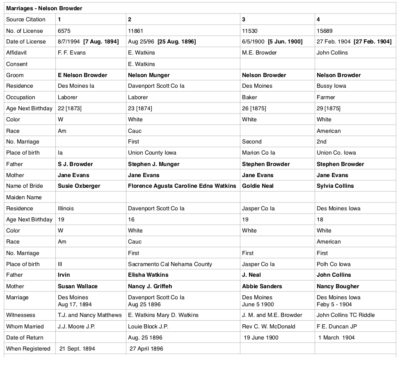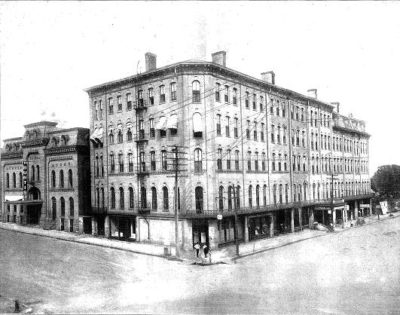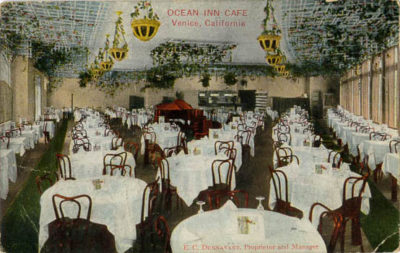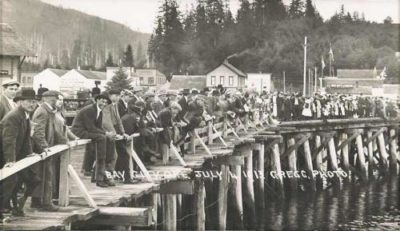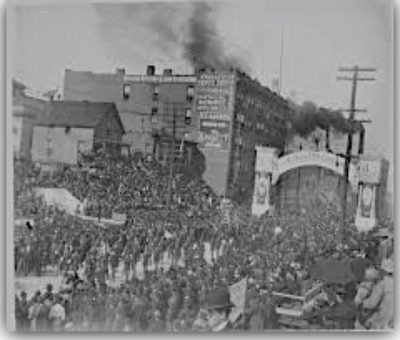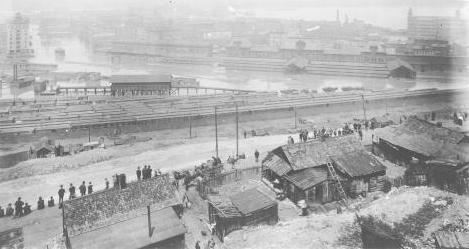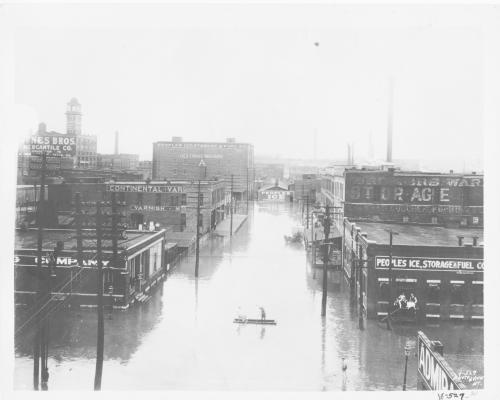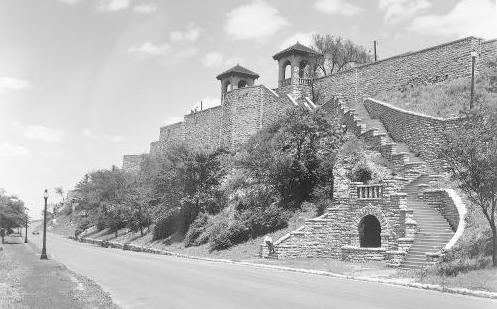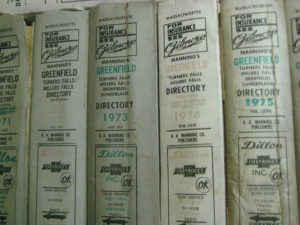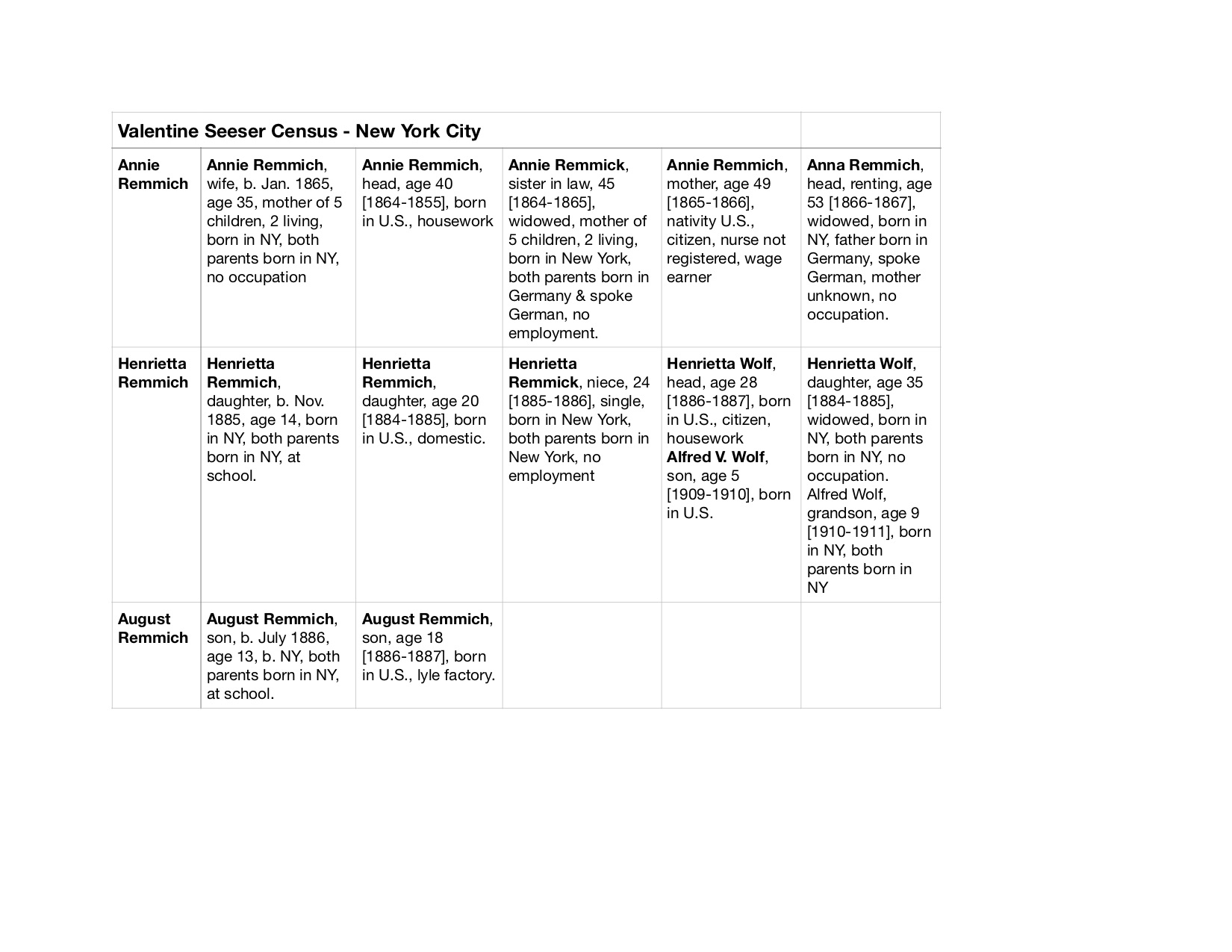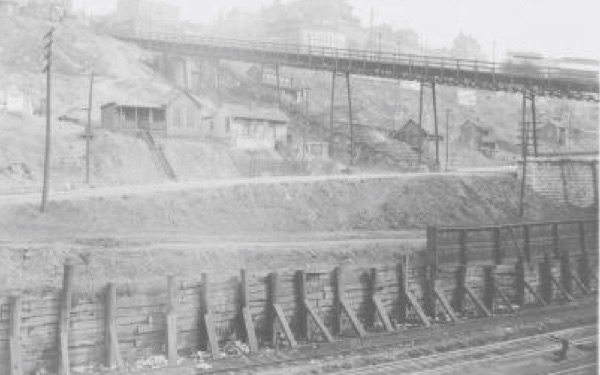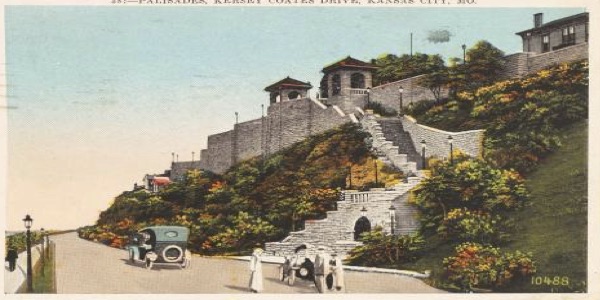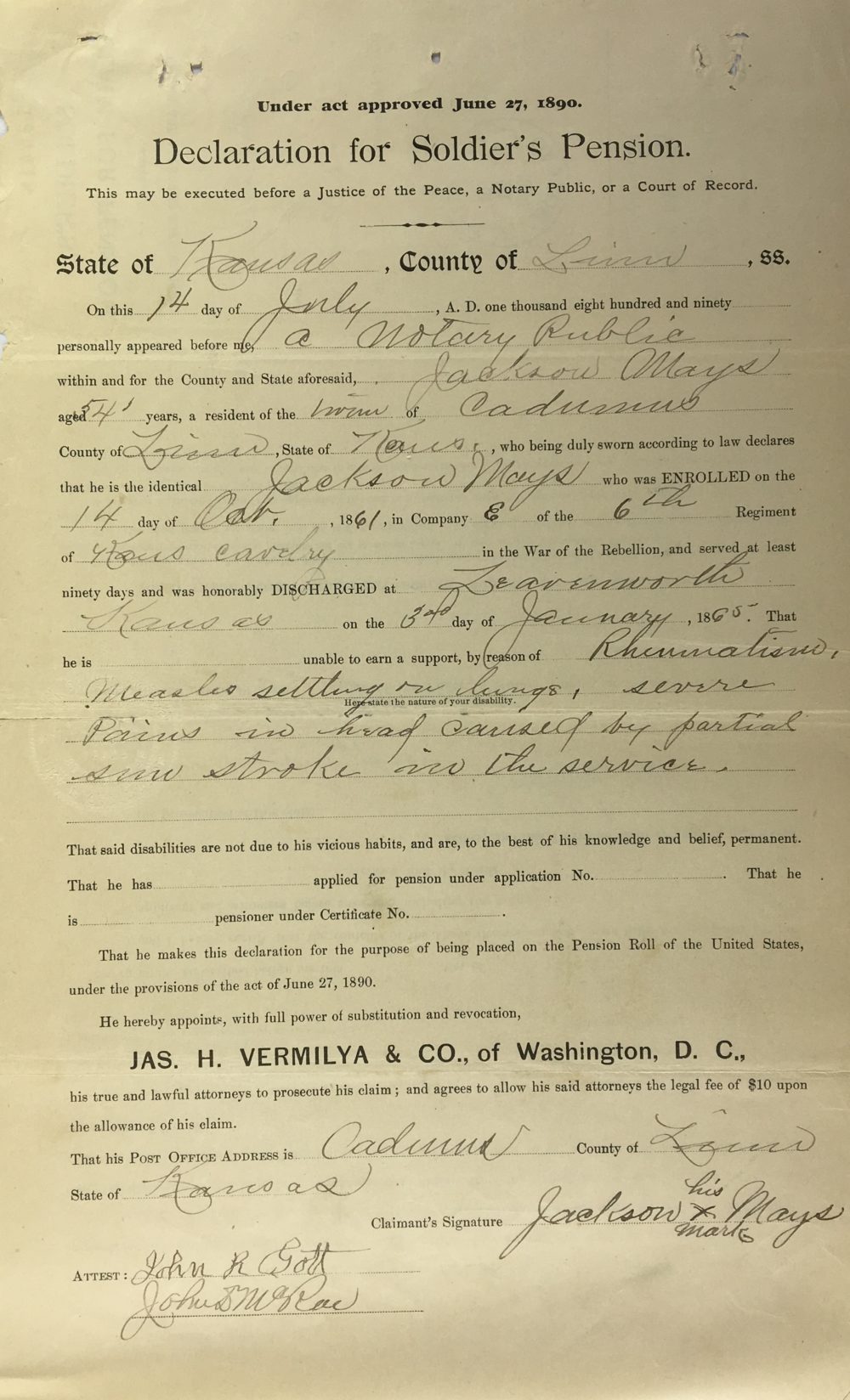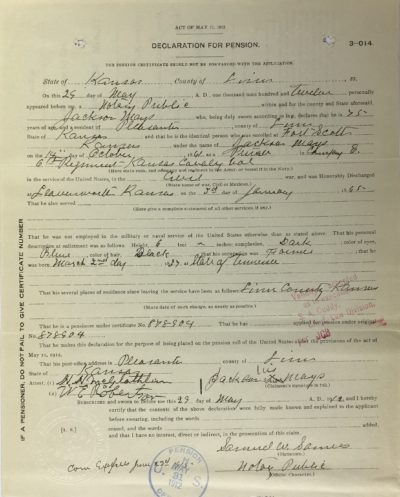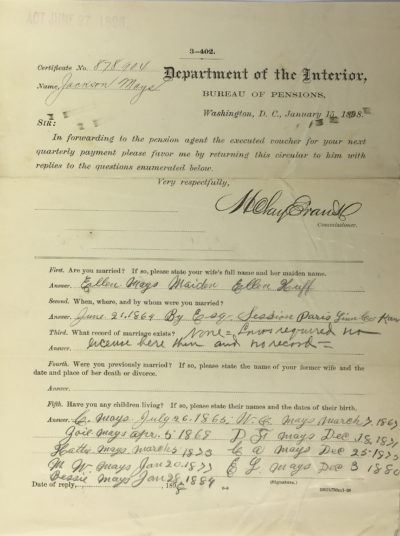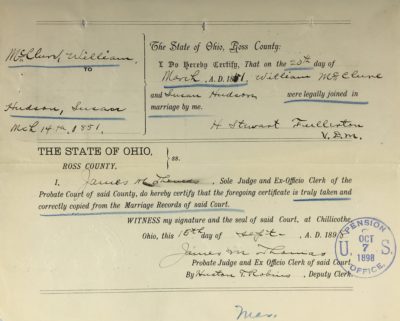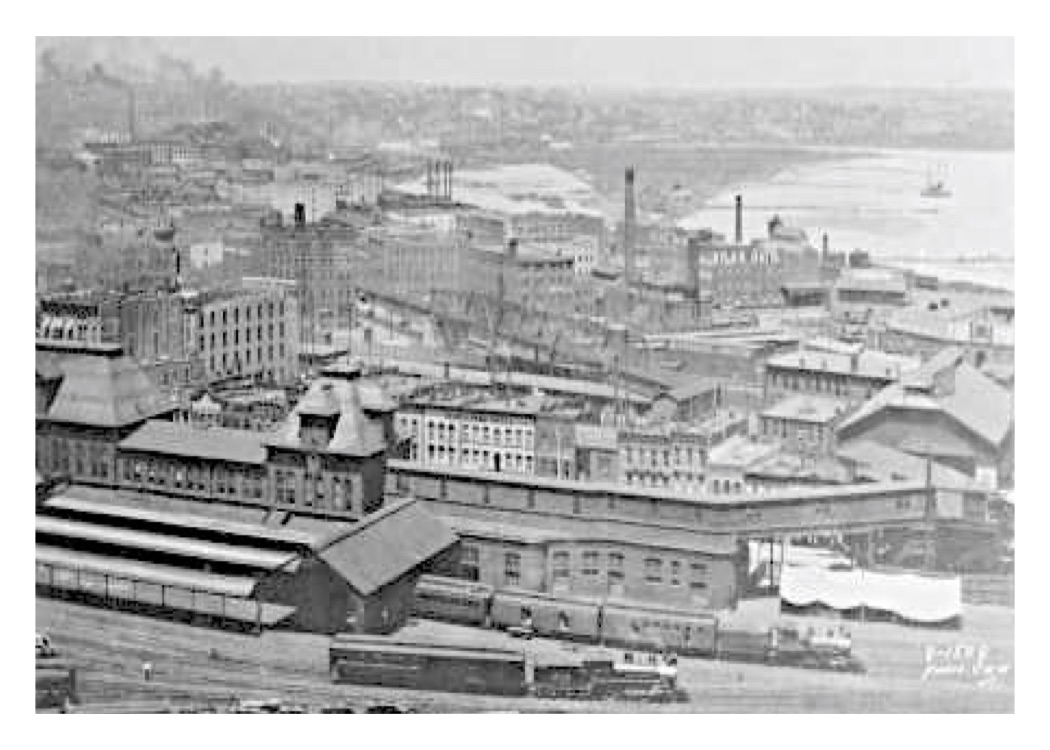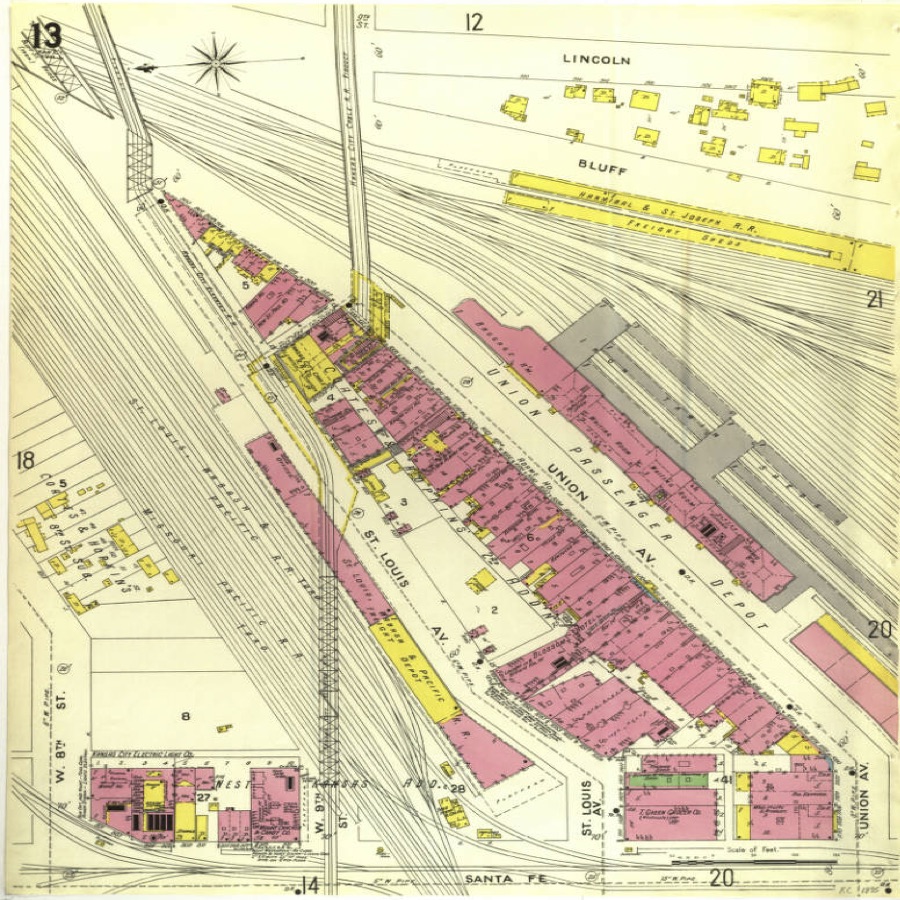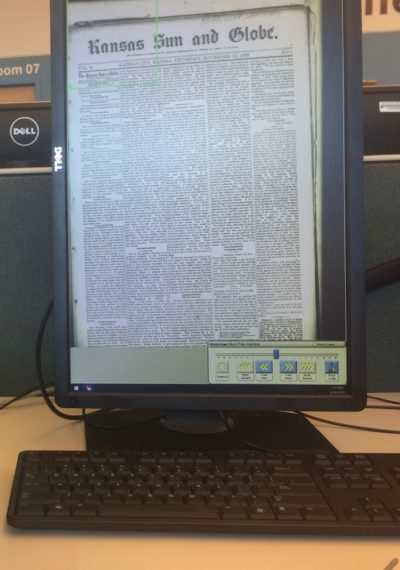On the evening of 23 April 1898, the platform at the Union Depot in Kansas City was amassed by the 24th Infantry, one of four African American units of the U.S. Army. The regiment had made a temporary stop in Kansas City to switch trains on their way to Chickamauga Park in Georgia, where American forces were preparing to deploy to Cuba to confront the Spanish defenders. The conflict was known as the Spanish American War. [1]
Men and women were reported standing close together along the “whole length of the depot platform” and “gazing curiously” upon the “brawny negroes” in their military blue coats and white hats. Certainly this was a queer sight to those unaccustomed to seeing blacks in full military gear and brandishing weapons. The sight of African American servicemen was so peculiar, many conversed with the white officers in charge, undoubtedly asking questions about the soldiers.
Who were these soldiers who captured such attention?
Answering this question, one will discover a heroic tale can be told. The story of the 24th regiment during the Spanish American War period is one of ordinary troopers overcoming outright bigotry, discrimination, and demeaning perceptions. For us today, the men of the 24th provide a study of how to transcend racial disharmony to one of inclusion and the higher service in the cause of humanity. These men performed such a task in a rather noteworthy way; baseball, the regimental band, discipline, and service, were keys to successfully overcome prejudice. But, it wasn’t easy as the story unfolds.
An African American Unit in the Spanish American War
When war broke out with Spain, the first units ordered to join the expedition to Cuba were four African American units, two infantry, the 24th and 25th, and two calvary, the 9th and 10th.
Kansas City citizens may not have been aware they were gawking at a first-rate, battle ready regiment. In an army barely consisting of a total of 26,000 men and 2,000 officers, these African American soldiers represented some of the most experienced of the army’s combat troops. The 24th had been garrisoned and serving throughout the Western United States for a number of years. [2]
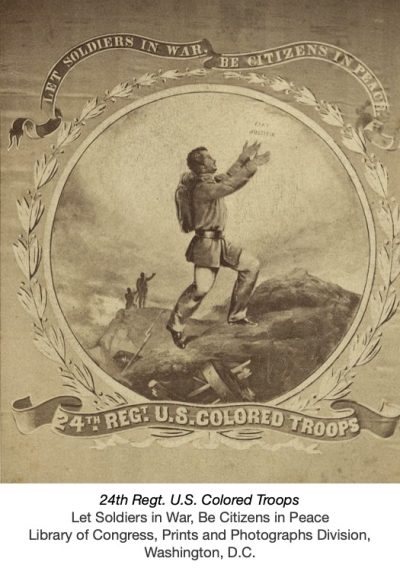
All of the different companies comprising the 24th had been serving continuously from 1869 to 1891 along the western frontier and border with Mexico. The regiment was scattered about in isolated posts and forts in New Mexico, Arizona, Texas and Indian Territory in Oklahoma. Their service included performing a number of various noteworthy duties which included fighting outlaws, bandits, indigenous Native American groups, Mexican incursions, civil disputes and mining strikes. [3]
The racial attitudes of the times questioned whether African Americans could be trusted or even capable of being soldiers. The performance of the 24th on the western frontier would suggest otherwise. For example, in 1889, two members of the 25th, Sergeant Benjamin Brown and Corporal Isaiah Mays, received the Congressional Medal of Honor for protecting an Army paymaster.
A U.S. Army War College study described the unit, as cohesive, well-disciplined, and highly competent during this period. Additionally, it held the lowest desertion rate among all regiments in the Army and had a “high espirit de corps.” Given the regulars had few opportunities available to them to be relieved from their isolated posts along the frontier, the discipline of the unit was noteworthy. [4]
The regiment was under the command of white leaders, but it was noted the bonds between officers and regulars was so strong many of the white NCO’s served their entire careers with extended service in the unit. Such racial unity filtered down to even the company level with many officers developing close relationships with those under their command. [5]
During the Spanish America War period, the 24th would become a model of the possibilities of racial cooperation. When the regiment had arrived in Kansas City, the men had just left their post at Fort Douglas near Salt Lake City where they had worked hard at capturing the hearts and minds of the local white citizenry. The regiment would have to overcome racial prejudice and effectively bridge the gulf that separated whites and blacks.
Arrival in Salt Lake City
When news arrived in Salt Lake the 24th was to replace the all white 16th Infantry in October of 1896 at Fort Douglas, the locals were quite nettled a contingent of African American soldiers would invade the city.
The Salt Lake Tribune published a scathing denunciation of the troopers prior to their arrival. The editor declared the citizens of Salt Lake did not want to be “brought in direct contact with a drunken colored soldier on the way to Fort Douglas” and certainly, as the newspaper complained, inebriated colored soldiers would not “shrink” from “asserting” themselves on street cars with ladies and gentlemen. The paper warned of “a strong revulsion in the minds of the best people” of Salt Lake regarding the new unit. The paper suggested “if laying the facts before” the Secretary of War, the “colored men” might be moved to some other location. [6]
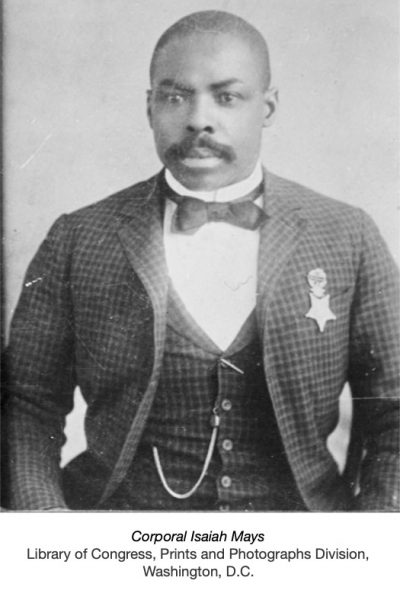
Senator Frank J. Cannon of Utah did just that. Cannon made an“earnest appeal” to the Secretary of War, Daniel S. Lamont, to have some other regiment besides the 24th locate to Salt Lake. Lamont was actually impressed with Cannon’s presentation of his concerns and even suggested he was agreeable to rescind the order. However, as Lamont argued, since he was leaving the War Department on the first week of March and as the order was already well advanced, he felt it was impossible to change things. The “colored troops” were coming. [7]
A white officer, Captain Hoffman replied to the Tribune’s objection in a letter to the paper. He stated he had known the regiment well and spoke highly of the men “as good soldiers as there are in the service” and “without exception” were a credit to the army and “an ornament to society.” Furthermore, Hoffman reassured the public “all fair-minded people will soon discover” the “colored soldiers” were well behaved, “keep to their own race,” and Salt Lake should “congratulate itself that we are to have among us so desirable and so agreeable” a people. In due time, Hoffman’s words would ring true. [8]
Yet doubts remained. The Salt Lake Herald published an interview with a Captain Crane pointedly asking him if the “prevailing race question” was the reason for the relocation of the 24th from the several posts the regiment held throughout the Southwest. Shaking his “head emphatically” Crane maintained the decision was based on “an act of simple justice” by the War Department. Crane explained. The regiment had been “shoved from pillar to post in the most desolate wastes” of Arizona, New Mexico, and Texas for years. A petition was presented by the colonel of the regiment for consideration of a permanent headquarters at Fort Douglas as an “award of merit.” Further, Crane elaborated “colored soldiers” were the most “tractable, obedient and by far the most easily disciplined of any on record.” [9]
If any doubts lingered concerning the African-American soldiers, The Salt Lake Herald dispelled any such worries. When it had first became known the 24th was replacing the all white 16th Infantry, “a good deal of comment and curiosity” had been made the paper recalled. However, after a few weeks, the paper noted, the curiosity “has been satisfied” and the troops are common place. The paper stipulated no complaints of disorderly conduct amongst the troops had been known and the street car conductors in charge of the lines from the Fort Douglas to the city had not experienced any trouble or “annoyances” as they had when the “boys’ of the 16th regiment held the post.” “This is all most commendable” the paper extolled and stipulated, how “silly and unwarranted was the prejudice expressed in some quarters” when the regiment had first arrived. [10]
The Salt Lake Tribune also commended the behavior of the troopers a year after their arrival in Salt Lake. The paper brought attention to the fact the troopers had exhibited “good behavior every day,” they were “less rowdy” and drank less than any white regiment at Ford Douglas. Finally, the paper insisted:
The rank and file of the Twenty-fourth has seemed to act all the time as though each soldier felt that he was upon his honor never to cast reproach upon the uniform he wears or the flag above him. There seems to be a double influence for good always with this regiment. …the regiment has lived down the apprehensions awakened when the announcement of their coming was made, and they are now appreciated at their worth, as citizens and soldiers above reproach. [11]
As the first units of the 24th arrived in Salt Lake in the fall of 1896, a large contingent of people watched the soldiers pass by as they marched the four miles from the train depot to Fort Douglas. Very few of the citizens of Salt Lake had “seen a colored soldier before so it was quite a novelty item for them.” As they marched to the fort, it was noted all of them were “an intelligent looking body of men” and they “presented a very creditable appearance.” [12]
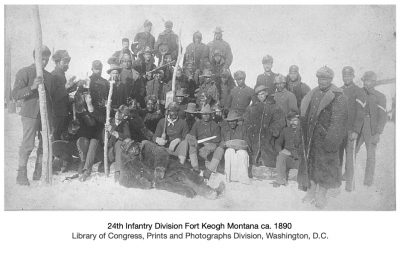
Another officer gave his opinion to the Salt Lake Tribune just as the men were arriving at the fort. He assured the newspaper readers “you will [see] our regiment better behaved and disciplined than most of the white soldiers” and the “officers speak very highly of the men.” [13]
With the arrival of the troopers, the African American population of the area increased two-fold as many of the soldiers would bring along their wives and children. According to the African American newspaper The Broad Axe, fifty of the black soldiers were married with families many of which belong to the church and assisted the regimental chaplain in his Sunday school work. [14]
Relations between the African-American soldiers and the Salt Lake citizenry appears to have been mostly amicable. Yet problems did arise. In a newspaper article of December of 1897, many “soldier fracases” were noted to have happened within the city. So much so, a “leading business man” encouraged a petition drive asking for the permanent withdrawal of the “colored troops” from Fort Douglas. In response, the paper defended the soldiers suggesting they had conducted themselves honorably along the streets and on the street cars. Furthermore, the paper felt they had acted “as well as any troops that were ever at the fort.” The paper proposed the reason for so many ruckuses came about from the availability of too many “low dives” the troops were resorting to for entertainment. These dives were destroying the good name of the regiment and the paper advanced the notion of ridding the city of such places. If a genuine effort was made to do so, the paper assured the readers, little more would be heard of the “soldiers breaking the peace of the city.” [15]
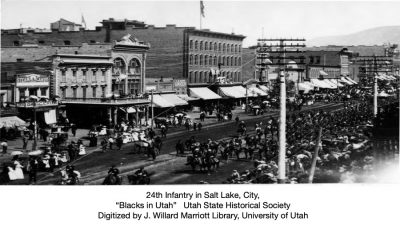
Despite some instances of drunkenness, relations between the white populace and the soldiers remained cordial. General Kent encouraged a number of interactions between the fort and locals which over time helped to facilitate closer ties between the races. For example, the soldiers offered monthly athletic exhibitions to the public who had contests in “foot-racing, bicycle-racing, jumping, and club-swinging.” The public was also invited to watch baseball battles between company units such as the “Chunks” of F Company and the “Chumps” of B company. However, the most anticipated games were those presented by the official regimental baseball team The Fort Douglas Browns. If anything endeared the buffalo soldiers to the citizens of Salt Lake, it was this regimental baseball team. [16]
Baseball
By early spring of 1897, “the crack baseball team of the regiment” began to make preparations for the upcoming baseball season. On the Fort Douglas parade ground, the men constructed a field, diamond and wood backstop fencing. Plans were forged for the Browns to play against all white teams organized around the Salt Lake City area, and states of Utah, Oregon, and Colorado. [17]
The Browns premiered their first contest on 5 May 1897 at 2 o’clock on the afternoon on their newly constructed baseball diamond. Played against the Oregon Short Line boys, the contest raised such an interest, the gate processed over two thousand people that day. The grandstand was filled with a “perfect maze of brilliant feminine headgear.” Some, including a few ladies, attempted to skip paying the twenty-five cent ticket price by climbing over the wooden fence that defined the outfield. [18]
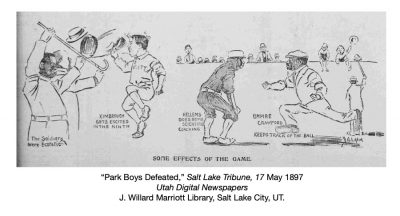
The soldiers won the game by a score of sixteen to four, and The Salt Lake Tribune printed a complimentary article describing their excellent play. However much more appealing than the play was the conduct seen on the field as illustrated by the newspaper:
They [Browns] played a good steady game, they conducted themselves more gentlemanly than their white antagonists, a fact appreciated time and again by the cheers that greeted the colored boys when time and again they surrendered points rather than become involved in a dispute.
As the game progressed into the later innings, the Short Line boys were facing defeat and began to “abuse” the umpire over a particular dispute. As the umpire walked off the field, which would have ended the game, the Browns insisted the umpire award the disputed point to the opposition to keep the game in play. In the ninth inning, one of the Short Line boys hit a fair ball directly to the pitcher who easily caught it. The hitter, after a minute delay, “ambled down to first” as the pitcher held the ball. Upon reaching first base the “white boys claimed their man safe on first.” “Rather than have a discussion” the Browns insisted the umpire call the man safe. According to the account, out of “pure generosity the colored boys allowed the other fellows to make a few runs in order to even up the score.” At the end of the ninth, the soldiers held onto their lead of two runs to win the game. [19]
The second game of the season, the Browns faced the Park City Miners who were undefeated from the previous season and their “name was a veritable terror to the ball tossers all over Utah.” The Miners came prepared with good luck charms, rabbits feet, a donation from L. E. Hubbard, who had collected them from a cemetery in the “dark of the moon at midnight by a red-headed, cross-eyed coon.” A fifteen cent admission did not prevent twenty-one hundred spectators from witnessing the contest. [20]
Prior to the start of the game, the crowd was entertained by “swarms” of boys who “perched on fences and shouted derisive defiance” at the two or three white jacketed soldiers acting as patrolmen. While a few distracted the officers, “hundreds of the lads clambered nimbly over the palings at different points” and melted into the crowds. The Browns prevailed that day with a nine to eight score in a hotly fought back and forth contest. [21]
When watching the Browns play, side entertainment was offered by the coach, Algy Jackson. For example, in a game against the Jubilees on 27 May 1897, Jackson was described as “offering amusements” in the form of “beautiful and endearing pantomime,” beating a “swift and rotary tattoo upon the side line,” with “two steps” and wildly moving his arms in the air with “noises” that would have made a “freight engine or circus calliope” sound weak. His “whirling antics” afforded much “amusement for the crowd.” [22]
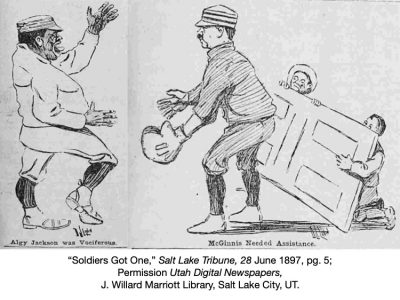
Play was so bad that day, numerous errors flew on both sides. At one point, after a particular bad play by one of the Jubilee players in right field, two boys carried out a large door to act as a backstop.
Baseball can hold its own magic and those watching could easily be enraptured by the drama played out on the diamond, and those who watched the Browns play, must have experienced this often. A game could swing back and forth up until the ninth inning, when everything could be decided by a single hit as illustrated in the summer heat of July 1897.
With twelve hundred spectators watching from the grandstands and sidelines, none were prepared for the bat action of the Brown’s left fielder, Armstrong. “Just as the curtain was about to fall over the ninth inning,” Armstrong came to bat. Everyone sensed a certain defeat by the Brown’s as they were behind two runs since the sixth inning. To make the final cleanup of the game, the Jubilees had just replaced their pitcher who had been injured in the sixth. The Browns had managed to load all the bases just as Armstrong’s turn to bat came about. As the “husky” Armstrong swung, the bat cracked, sending the ball upwards:
….as opportune as a rain storm on a parched Texas farm. It soared and soared, and almost before it had reached the alkali wastes on outside of the fence, Armstrong was gathered up by a crowd of enthusiastic admirers and carried in triumph among the crestfallen and agonized Jubilees.
Armstrong’s hit flew yards clear of the back fence and brought in three “dusky soldiers in from the bags” giving the Brown’s the unexpected win. [24]
Earlier in the day, two of the Brown’s scores came from the powerful hits by the second baseman and the short stop, who “found the towering board fence” of the outfield “too small an obstruction” when they hit their home runs. Richards, the Brown’s pitcher, had argued with the umpire throughout the game over decisions “with tremendous energy” and his “mood” was more apt as if he had been “Indian fighting.” Adding to the drama, Richards even threatened to quit at one point after a call was made against his team, and Captain Ducat, “in full regalia of officer of the day” appeared on the field to order Richards to go back to the pitcher’s plate. [25]
After being rattled by bad calls, Richard’s temper got the best of him and the Jubilee batters were able to take advantage of him. But, in the ninth inning, he hit a home-run narrowing the gap for the Browns to 4 – 6.
At one point when the Brown’s second baseman was knocked over by a Jubilee player, the soldiers produce a grand theater of protest, as they “beat the air wildly and tore it with hard, strident voices” creating such a “rabble” more “obstreperous than a discussion in an East London fish market.” The soldier’s protests became so vocal, Captain Ducat had to enter to “breach and order the musketeers back onto the field.” [26]
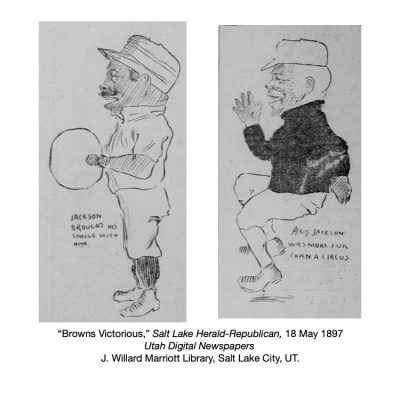
Attendance to the games marked how popular the troopers’ team was to the locals bringing over a thousand people during home games. Baseball became a form of unity between the African American players and the white Salt Lake City citizens who came to watch them play. And, momentarily, racial divisions were set aside as both sides felt a communion together. For the soldiers, the baseball team was a source of pride and demonstration of their prowess and capabilities as men. They demonstrated, on the diamond, they were equals in ability, aptitude, and fair play.
Such pride was on display the day Armstrong made his spectacular home-run against the Jubilees as a “horde of yelling, delighted soldiers” carried him off the field in grand jubilation. And, to those they vanquished that day, “the defeated nine” were pleased by the troopers. Those who played against the Brown’s, knew they faced formidable opponents and in the end brought out the best in whomever faced the dough boys. [27]
Newspaper articles chronicled how the Brown’s players offered sideline entertainment during the baseball competitions. In one game towards the end of the season, a Browns player, August J. Reid, “in a hilarious mood” kept the players and spectators “convulsed during most of the game by his antics.” Late in August, a group of local boys, made up of grocer workers from Salt Lake, fought the Browns in a heavily one sided nineteen to two game. Towards the end of the game, “several of the husky” Browns stood on the sidelines and “coached the despairing grocers.” Whenever the grocer’s pitcher struck out a Browns player, the “voices of the Browns were raised in cheers of encouragement.” [28]
In anticipation of the 1898 season, the soldiers, making use of their own proceeds, were determined to improve their ball park and increase the seating capacity to accommodate the expectation of large crowds. The back stop fence was moved to make room for additional grandstands and a wire netting was added to protect spectators. The ground was leveled off, grass seed sown, an irrigating ditch dug was added to supply the field with water from the post, and new uniforms were procured. [29]
Prospects were high for the 1898 baseball season as the Browns were invited to participate in a new league that was to play from May to October and to finish with a pennant competition at the end of the season. The Brown’s had reorganized the team filling vacant spots after loosing their second baseman, center and left field men. However, all these plans were placed on hold when news arrived of the departure of the regiment to Cuba.
On the eve of the departure and after a concert by the regimental band, “several hundred” spectators watched a game between the Brown’s consisting of various companies of the fort and an aggregate city team named the Colts. The Browns won the game sixteen to fourteen. But, the victory would be bittersweet. The memorable team that defied racial barriers and won the hearts and minds of Salt Lake City would only become a memory to those who fought them on the diamond and to those who were enraptured by their performances. After the war, the Browns would never again play on the diamond. [30]
Athletic Competitions
The soldiers offered another form of public entertainment, various athletic competitions. For example, in the spring of 1897, contests were offered in various events which included a 100 yard dash, broad jumping, flat-foot walk, and skirmish race where soldiers were required to run 50 yards, then grab a rifle shooting five blank cartridges and run back.
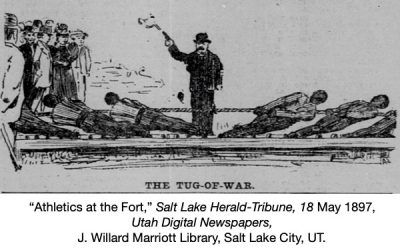
In one memorable contest, the action was interrupted by an impromptu dog fight between a brindle bull dog and shepherd belonging to two company units. As the two dogs began a vicious fight amongst themselves near the flag staff, “every man forgot all about the races and other events” and gathered around the pugnacious hounds and started making bets. A “dense mass of shouting, crowding” and “excited humanity” encircled the dogs. Noise and dust gathered about the crowd which moved in mass as the dogs changed directions. Captain Ducat was accidentally forced into the melee whereupon the dogs became entangled in the captain’s legs. As the regimental physician Dr. Kirkpatrick attempted to assist the struggling captain, he lost his balance, tripped and fell, whereupon the crowd “tramped on and over him and left him to brush the dust from his clothes.” [31]
After the dogs were finally separated the events continued and ended with a sixteen man tug of war lasting twenty minutes. Certainly the troopers made a lasting impression upon many of the citizens in Salt Lake City that early spring season. Yet, one of the most endearing parts of the regiment to the people of Salt Lake was the regimental band.
Regimental Band
When the troopers began arriving at Fort Douglas, a newspaper article suggested they were a “well-disciplined, courteous class of men” and all that was needed to make Salt Lake like them is to “hear their crack band of twenty-two pieces.” In many ways the regimental band made this certain. [32]
The band offered concerts every Wednesday and Friday evenings during the summer of 1897. A newspaper article noted the band had become one of the star attractions to the “thousands of visitors to the post” and the services of the band had become so demanding, there was a “danger of its members running short of lungs.” [33]
After performing in the Memorial Day services of Salt Lake, an encomium was published by The Salt Lake Herald honoring the band. The paper made a request to the people of the city to recognize the “many services” the band had rendered “on many occasions” whenever an appeal was made. Having never rejected a request, the men of the regiment, the paper concluded, “seem to take a pride in helping out” whenever asked. The paper further pointed out, the soldiers “feel they are a part of this city” and take it as part of their “duty to do all they can to make matters pleasant.” Such a quality the paper noted had not been on “display” to such a degree by any other “military band stationed” at Fort Douglas for a long time.
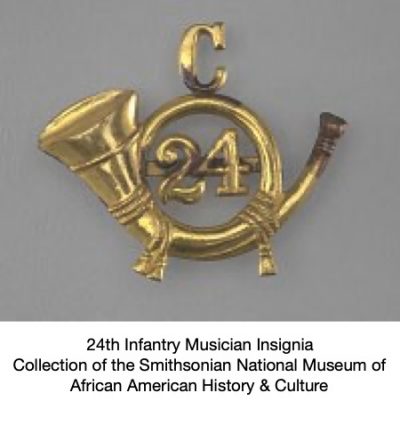 The Regiment provided opportunities to share African American cultural and pride to the white citizenry. An example was an affair called the “Emancipation Proclamation Entertainment” held at the Fort Douglas post chapel. The public was invited to hear several “vocal solos, instrumental selections, and addresses” all of which were “meritorious.” The regimental chaplain Captain Allensworth, read the emancipation proclamation followed with remarks. The chaplain took time to thank the Salt Lake Herald:
The Regiment provided opportunities to share African American cultural and pride to the white citizenry. An example was an affair called the “Emancipation Proclamation Entertainment” held at the Fort Douglas post chapel. The public was invited to hear several “vocal solos, instrumental selections, and addresses” all of which were “meritorious.” The regimental chaplain Captain Allensworth, read the emancipation proclamation followed with remarks. The chaplain took time to thank the Salt Lake Herald:
“It gives me great pleasure to speak this evening of the kind and friendly way in which the Salt Lake Herald has always spoken of our regiment. It has always treated the soldiers with consideration and justice and has never shown anything but friendliest feeling toward us. We appreciate this and I am sure there are none in our regiment but have the kindliest feeling and greatest respect for The Herald.” [34]
A “great number of people from the city” came to watch a full dress parade followed by a concert given by the regimental choir and mandolin club, who’s organizer and leader was “Professor Loving” or Walter H. Loving. He had so impressed the public that evening, he tipped his cap to a “a delighted audience that sat in raptures over his musical work.” As leader of the post choir, Loving had a voice with “the power to charm” his audience:
Loving has shown that his voice – which so often is heard on the baseball field crying “slide, Reid, or you’ll cash your checks” – had the power to charm as well as coach. He is leader of the choir and fills his position with credit. He is also leader of the mandolin club and shows that his fingers can touch the strings of a mandolin as deftly as they can grasp a baseball bat. 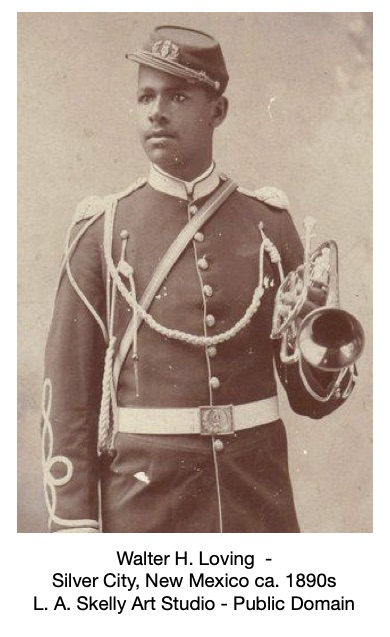
Loving joined the army in 1893 and was assigned to the 24th Infantry stationed at Fort Bayard, New Mexico Territory where the regimental headquarters was located and was eventually transferred to the regimental band. After the regiment was stationed at Fort Douglas, besides playing the cornet and violin in the band, Loving offered free vocal lessons. In January of 1898, the managers of the local High School minstrels sought out his assistance in orchestrating their music performance at the New Grand theater which was “well rendered” by the public. [36]
African Americans celebrated “Emancipation Day” with a parade in Salt Lake in September of 1897 with the 24th Infantry band leading the procession. The members played with such “soul – stirring they “touched all hearts” black and white. The day’s events culminated with Captain Allensworth providing the oration at the Salt Lake City G.A.R. hall which was filled to capacity. Of all the soldiers who represented the character of the regiment, Captain Allensworth, the only African American officer in the U.S. Army, did so. [37]
Captain Allen Allensworth
Captain Allen Allensworth was a former slave of Kentucky and was the greatest advocate of the men who served in his unit. More than anyone Allensworth contributed to the good will established between the African American soldiers and the citizens of Salt Lake.
Allensworth was nominated by President Cleveland to be the chaplain of the 24th Infantry in 1886. His nomination as a captain was approved by the Senate on 1 April that year and he was ordered to join the 24th stationed in Indian Territory in Oklahoma at Fort Supply. After serving a decade with the unit, Allensworth became instrumental in getting the regiment fully consolidated and removed from the frontier to permanent headquarters at Fort Douglas in Salt Lake City. [38]
For thirty years the unit had been restricted to remote posts until Allensworth had cleverly commissioned a letter featured in the prominent African American newspaper the New York Age. The letter outlined the problem of solders refusing to reenlist after serving along the outlying frontier posts. To alleviate this situation, he argued for a more equitable policy in how and where Army units were stationed. After publication of the article, Allensworth sent a copy with an attached letter of explanation to Congressman John Mercer Langston who then arranged a meeting with General Miles. Langston’s influence and friendship with the general helped to recognize it was time to reward the 24th’s illustrious service in a less remote area. Orders were given to the regiment to relocate to Salt Lake. [39]
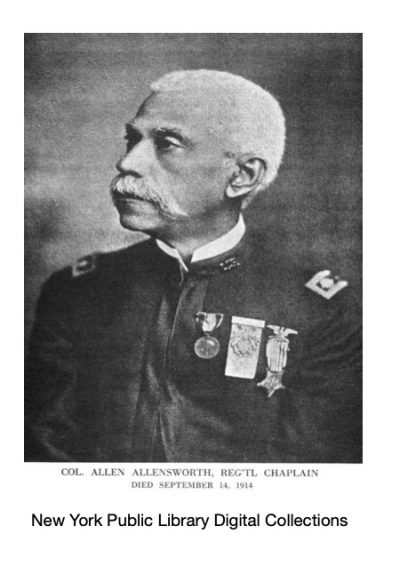
The chaplain was a fierce supporter of the enlisted men and assured a newspaper reporter that during his ten years while stationed at Fort Bayard, New Mexico, no white, either lady or gentleman, ever complained or “claimed that they had been insulted by the colored soldiers in any manner, shape or form.” Further, he was convinced the great majority of the men would act like “gentlemen, and as such they will not insult a true lady.” He even went so far as to suggest the city could assist in good relations by refusing to “entertain” the soldiers in the “saloons, gambling houses, and immoral houses” found in the area. And, if any woman, “black or white” attempted to travel on the street cars to and from the fort, he would hope the police would arrest such “braven-faced” women. [40]
As an officer, Allensworth made it his personal ambition to instill integrity in his men inside and outside Fort Douglas. He attempted to dampen as much as possible certain negative influences found in the city by instituting a number of activities, entertainment, and literary organizations within the garrison. He warned his troopers that no matter what may happen in the city this would certainly be charged against them. Wether a decrease in the value of property or increase of crime, the regiment would be given credit. The consumption of alcohol in particular would be a bane to the regiment as the captain warned the men, they could not afford “under any circumstances” to indulge in such a thing. [41]
The captain encouraged accountability as the primary means to maintain order and self-respect by organizing the entire command into a “corps of sappers and miners” which included the families of the enlisted men. Membership into the corps required a simple yet effective affirmation:
“Will you mine and sap the life out of everything that militates against the reputation and efficiency of the members of the 24th Infantry, and that interferes with the peace and harmony of this garrison?” [42]
When met with difficulty anywhere, each member was encouraged to ask the chaplain for “instructions on how to handle it.” Meetings were formed where “battles fought and victories won or lost” were shared.
In many ways Allensworth promoted a program of self-help to advance the African-American soldiers. The army had instituted compulsory education in mathematics and American history at all army posts. At Fort Douglas, chaplain Allensworth became the “ex-officio superintendent” of the post school. At one time the school had a membership of 120 students taking various classes in grammar, arithmetic, history, as well as in printing, telegraphy, clerking, and signaling. [43]
In a speech entitled Freedom’s Triumph, given during the “Emancipation Day” celebrations in 1897, Allensworth urged “the race” to pay less attention to politics and more to improving social status and industrial pursuits. He added, “commercial and political” success depended on advancements in moral, intellectual, and social arenas. He preached legislation in the country was designed to prevent the “growth of manhood” and placed “stigmas and barriers” against African Americans. Such treatment to any “class of citizens” would continue to bring disorder, but this could be overcome with proper industry. In the face of such obstacles, he enjoined his fellow listeners to “brace up” by using all means “used by every successful man or woman to succeed in life.” For Allensworth, the men he directed in the 24th infantry were models of this upward movement of African Americans. [44] 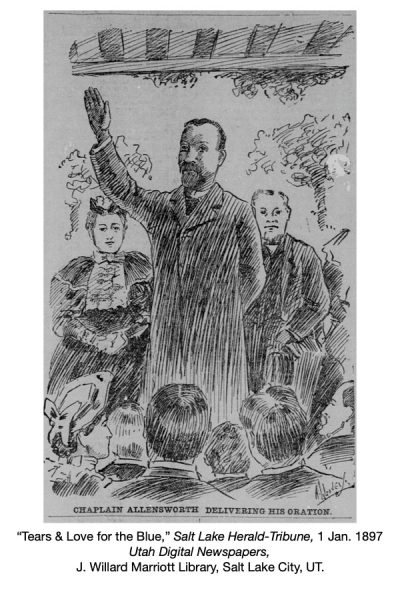
Allensworth was placed in charge of the post vegetable gardens, a massive ten acre plot. He felt it was important to fill the stomachs of the men for six days of the week “so that on the seventh he may fill their minds.” [45]
In his capacity as a chaplain, Allensworth spoke often at many of Salt Lake City’s various churches and was requested by various civic organizations for lectures. For example, he spoke at the Utah University with an invitation to deliver one of his popular lectures, “The Battle of Life and How to Fight it” and more than once he delivered sermons at the all white congregation of the First Presbyterian Church in Salt Lake representing the first African American to do so. [46]
As a Civil War veteran, Allensworth joined the James B. McKean Post No.1 of the G.A.R. in Salt Lake City, and was given the honor to deliver the oration for the city’s Memorial Day celebration in 1897. The Salt Lake Herald published the entire speech. In his oration he honored the veterans of the Civil War, the sacrifices made in the cause of democracy, and appealed to his listeners to the ideal of freedom for all races:
“Where could the ideals of democracy have found a grander realization, a wider scope, than on the broad continent of America? But to preserve them intact, to make them a continual and pure reflection of a people one in heart and purpose and action, from the great lakes of the north to the great gulf of the south, the body as well as the spirit of every inhabitantof this glorious land was ordained to be free, and the ordeal of our four years of sanguinary war was not in vain.” [47]
Off To War – The Send Off
Word began to spread through Salt Lake of the imminent departure of the 24th early in the spring of 1898. The town began to make arrangements to honor the troops by affording them a parade and grand send off. Beside showing their patriotic pride, the citizens would also extend a genuine affection and outpouring of honor towards the African Americans who had cultivated a real sense of kinship to those of the area. The Salt Lake Tribune highlighted this sentiment:
In the regulars, ebony of skin though they were, the people recognized a kinship impossible in time of peace to be conceived. They were regarded as representing the dignity and honor of the Republic, and the people were anxious to display their sentiment toward the Nation’s defenders. [48]
There was a bond between the white citizens of Salt Lake and the African American regulars at Fort Douglas as evidenced by the last public performance of the regimental band on the eve of the departure as illustrated by a writer of the Salt Lake Tribune:
Two thousand people stood with uncovered heads at Fort Douglas yesterday afternoon while the Twenty-fourth regiment band played the “Star Spangled Banner.” It was the concluding number of the concert programme. As the first notes of the stirring air rang across the plaza, a group of officers who were lounging on the plaza of a Captain’s quarters sprang quickly to attention and removed their caps.
The example was followed not only by the other officers and enlisted men but by the civilians present generally. From the ball ground far below came a faint echo of cheering as some favorite player pleased the fancy of the crowd. The sun, from its lofty elevation in the western sky, shot a glint of gold through the new-fledged leaves in the trees around the band-stand and touched the uniforms of the players with a gleam of glory.
The throb of applause that greeted the opening bars of the anthem gave place to silence so profound that the air seemed fairly drip with the music. At that moment, as never before, it dawned upon the amusement seeking crowd that it had a common flag and a common country, with thousands of brave men to keep the one from being dishonored, the other from being disgraced.
Not until the last notes had died away was there another demonstration. Then a wave of hand-clapping rolled from end to end of the audience. The demanded encore was not given, and what was probably the last concert at Fort Douglas for many a day was over. The rich who had come in carriages, others who used the street cars and the pedestrian classes felt very near to oneanother as they slowly left the post. [49]
On the day the regiment received orders to mobilize, the men were marched from their barracks and stood at attention near the regimental commander’s headquarters. Captain Allensworth, who exemplified the spirit and pride of the 24th, was given the honor of addressing the men. On top of his horse Allensworth spoke to the men with respect as he pointed out to his fellow “buffalo soldiers” that history had given them the opportunity to not only show their pride, but also had an occasion to highlight their patriotism and honor as black men.
Soldiers and comrades, fate has turned the war dogs loose and you have been called to the front to avenge an insult to our country’s flag. Keep in mind the eyes of the world will be upon you and expect great things of you. You have the opportunity to answer favorably the question, ‘Will the Negro fight?’ ‘Quit yourselves like men and fight,’ — and ‘Remember the Maine!’.
Your officers will stand by you. See to it that you do your duty as soldiers to them. Farewell. [51]
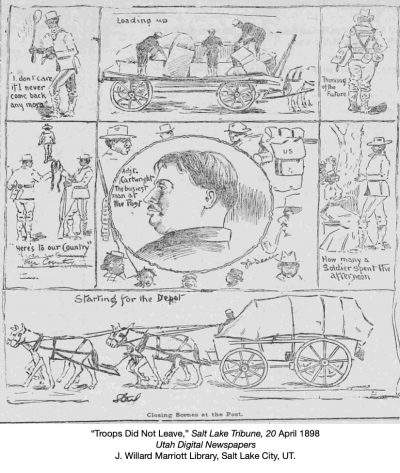
At the conclusion of the speech the men where full of “enthusiasm” and “marched away with cheerful step” toward the “service before them.” They would take up Allensworth’s challenge in many ways. [52]
Captain Allensworth was not destined go to Cuba with his men, but was ordered to remain behind. He was appointed by the commanding officer of the regiment to act as a recruiting officer to enlist soldiers for the war effort. Eventually, after twenty years of service in the U.S. Army, Allensworth was promoted to the rank of lieutenant colonel in 1906, the first black officer to receive this rank. [53]
The Salt Lake Tribune predicted the men of the 24th would “bear up very well” as Allensworth had instructed. Further, the newspaper felt the soldiers were “fully and keenly” aware of the “gravity of the situation, and were “determined to enter the conflict unflinchingly.”
It can be said without a vestige of doubt that when the roll called at the destination of the regiment that every man will answer “Here!” They realize the fact that an engagement means that many of them will never return to this post or to their homes again, and they consider that one to the fortunes or misfortunes of war and are prepared to meet it. If an engagement should take place, I think it safe to say that it will be said afterward that the Twenty-fourth infantry did their whole duty. [54]
Events in Cuba would show the 24th not only performed their whole duty most honorably but with extraordinary distinction. Meanwhile, the city made plans for a grand parade.
The March Thru Salt Lake
“A monster demonstration had been planned” for the departing regiment on 19 April as citizens of Salt Lake thronged the city streets by the “thousands” waiting to watch the troops march towards the train depot. Waiting for twelve hours they were “grievously” disappointed as official orders were not received until 10:30 that night the soldiers would not to march until the following day. [55]
Throughout the day people could be seen at every window and thronged along the sides of the streets where the soldiers were to march. “Patriotism kindled every eye and patriotism flowed from every tongue” that day. The city was aglow with Old Glory waving from a hundred flag poles and every public building. Photos of the sunken ship The Maine were posted as a reminder of the “national crime to be avenged.” Even the citizens were adorned with American flags; boutonnières for the men, red, white, and blue streamers for the ladies’s hats. Flags could be seen on baby carriages, horse bridles, drays and all types of wagons. [56]
Classes were dismissed by the school superintendent as teachers brought out “12,000” students downtown to witness the parade” while members of the Utah National Guard assembled to lead the planned parade.
At the fort, as wagons were loaded with rations, equipment, and ammunition, early in the morning, visitors came to witness the activity. By early afternoon more than a thousand in carriages, horseback, and by foot, watched the packing, and as tarpaulins were slung over the piled high vehicles and the mules were brought out to be hitched to the carts. Anticipation grew the march was about to commence.
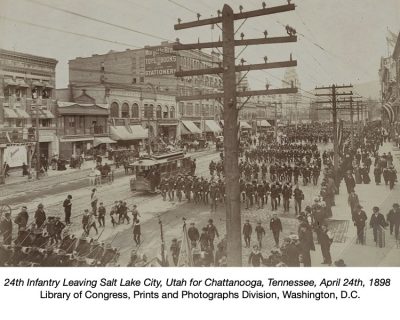
From 12:00 noon onward, “uncounted thousands” gathered along Brigham and Main Streets with many spending the afternoon “promenading” about waiting for the march of the troops. As the afternoon led into the early evening, the crowds grew even larger as many felt at any moment the troops would begin their march. The anticipation was so acute, when the noise of a band was heard, a rush of people instantly mobbed the streets. As the band drew near, a “mighty shout of laughter” wafted into the air as the musicians were discovered to be a half a dozen boys with drums and whistles playing “merrily and with vigor.”
As word came late in the evening the troops would not march until the following morning, disappointment set in. But, all in all, “it was certainly a day never to be forgotten by soldier or civilian” and the memory of it would “be altogether pleasant”
The next day, the enthusiastic crowds from the day before, came out once again in force. The Salt Lake Tribune boasted racial prejudice had disappeared, class distinctions forgotten, the “barriers of caste swept aside” and “the color lines obliterated” as men of color marched as part of the nation’s defenders:
It was with a magnificent outburst of patriotism, as spontaneous as it was all pervading, that the citizens of Salt Lake bade godspeed to the departing Twenty-fourth infantry yesterday. When the struggling sun dissipated the clouds that veiled the sky and touched the standard of the Republic unfurled over the regiment, it shone also into the hearts of the thousands who had assembled to shout and weep their encouragement of the cause of humanity. Uncounted multitudes acclaimed the flag of their country in cheering its defenders.
As the hour finally arrived, the troops lined up in ranks, as the regimental band played The Girl I Left Behind Me, a voice rang out, “Forward, march.” Leaving the fort, the soldiers marched down Penrose drive to Third Street. At the corner of S Street the troops were given a salute in “full regalia” by the decorated Union Civil War general W. H. Penrose. Marching in columns of fours, they were met by a “vanguard of the multitude” and a continuous ovation could be heard as the troops paraded down the three mile journey to the depot.
The crowds of spectators grew denser and pressed into the street, where they uttered their patriotic praise and encouragement. For once race and color were of no moment and the people saw only American soldiers going to defend their nation’s flag. [58]
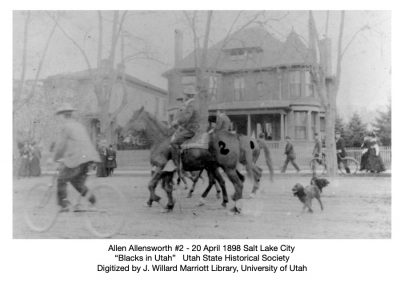
Ahead of the column rode Colonel Kent, Adjutant General Cartwright, Surgeon Kirkpatrick, on their prancing steeds. Among them, and most likely the proudest of the group, rode Chaplain Allensworth. With the band leading the company columns, the march was a “rolling cheer and a continuous wave of enthusiasm” with young boys running in front as escorts and the streets were “alive with moving horses and bicycles.”
The National Guard met the marching men at F Street who presented arms as they passed. As the guard contingent joined the end of the parade, pupils of All Hallows College drew up alongside the regulars saluting and joined in behind the guard. [59]
Near East Street, the column halted as twenty veterans of the G.A.R. post, dressed in their blue officer coats, greeted Colonel Kent and his staff with flowers from the women of the post with a card inscribed: May God be with you till we meet again. Don’t forget the ‘Maine.’ [60]
At the presentation of the flowers, the crowd gave “three cheers and a tiger” for the women and three more for the veterans. With flags and bunting festooned over every business, flags waving in every hand, the streets were lined with a “living wall of people.” Both officers and men were visibly moved by the emotions exhibited by the people.
A contingent of mounted police officers acted as a vanguard to help clear a path among the throngs of people. As the soldiers strode by, comments were heard of the impressive discipline on display, on in particular was overheard, “Those fellows will make a terrible fight!” Described as looking “business like” with belts “bristled with bright cartridges, the rifles as well as the pistols of the officers showed the regiment “was made for business more than show.” [61]
Cannons were fired, bands played, and a float bearing a sign, “Remember the Maine,” greeted the soldiers at the depot.
At the rail yards, people crowded the trains, with hundreds of men and youths climbing to the roofs of the coaches and nearby freight cars. While waiting for orders to load the cars, the regimental band provided an impromptu concert. Once inside the cars, women held their children up to the car windows to grasp a soldier’s hand. Other women, “with tears streaming down their cheeks” went about the cars shaking the hands of the privates wishing them godspeed and safe return. Offering “trinkets” to the departing soldiers, they “accepted the offerings with the debonair grace of heroes to the battle born.” [62]
If anyone would have any doubt concerning the outpouring of pride and sincere feelings toward the men of the 24th, a defining moment was recorded along the train platform just as the cars were about to pull away. An old lady, with “snow-white” hair and “bent with age,”
approached one of the car windows where two privates were seated. She reached out her “trembling hand” with the men grasping it in return. In clear and strong words the elder lady spoke, “Good-by boys, and God bless you.” Then with a “quivering voice,” she spoke again as a “tear stole its way down her cheek:”
I sent two boys to help free you, and they never came back. Now go on and free Cuba. [63]
As the train finally pulled away the crowds continued cheering and waving flags, which was repeated at the depots in Provo, American Fork, Springville, and other towns in Utah. Even along the countryside people waved hats and flags in greeting as the train made its way.
Shipping Out For Cuba
Thirty officers, seven hundred and forty men, two hundred horses, and all the regimental equipment was loaded onto the transport ship City of Washington on 8 June 1898 in the bay at Tampa Florida. The City of Washington, with the rest of the U.S. military squadron, remained at the bay until 15th of June. As a precaution, the fighting men remained onboard the ships as the location of the Spanish fleet was unknown. The flotilla reached Santiago Bay in Cuba, on 20th of June, but the 24th remained aboard ship another five days coasting around the bay before receiving orders to land. The men were confined on board for seventeen days and the conditions they faced on the ship would forebode of suffering and undue hardship to come while in Cuba. [65]
Twenty-seven transports made up the flotilla of the Army of the Fifth Corps, where men were crammed together on ships originally designed for freight and cabin passenger service. In the rush to get soldiers into the field, expediency rather than comfort and the welfare of the men was emphasized. Bunks for soldiers were made of rough lumber, three to four tiers high and built in the holds and lower decks of the ships with some constructed on the main deck offering no protection from the sea. The bunks were packed so close together there was hardly any room to pass between the aisles. If port holes or hatches were closed in bad weather no ventilation could be offered below decks. On the City of Washington, the men slept largely on deck. [66]
Accommodations for cooking facilities were very limit as the ship’s small galley was insufficient for the number of those on board. The soldiers were supplied with fourteen days of rations which, after a week, became “unpalatable” and “to some extent nauseating.” A large part of the rations included canned roast beef that was “very distasteful to the men.” Due to the lack of an adequate kitchen, men would try to eat the beef raw creating further discomfort. The regiment was finally ordered to land in Cuba on June 24th. [67]
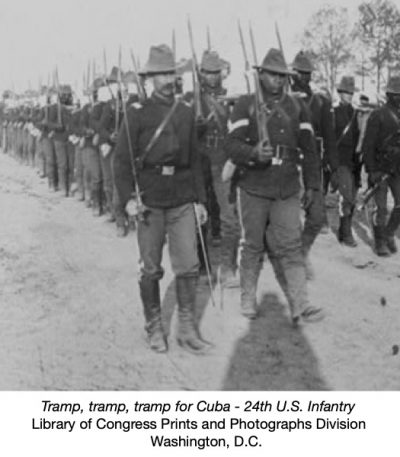
The Landing
The regiment was the last to land at Siboney, Cuba, the major operational point of the expedition. Taking three hours to disembark, the unit marched north with each soldier carrying only a blanket, half shelter tent and three days rations. Marching a half mile, a camp was established at a “beautiful cocoanut grove” the men named “Cocoanut Hollow.” Here the unit remained for three days and nights subsisting primarily on cocoanut milk and native fruits.
The soldiers watched as other brigades made their way towards Santiago, Cuba as the 24th was being held in reserve and would be the last to reach the battle front. On the morning of June 27th, the men marched out of Cocoanut Hollow. They arrived at Las Guasimas where they set up camp on ground that had already been made hallowed by American troopers who had fought a pitched battle the very day the 24th had disembarked. Three days passed when, at four o’clock in the afternoon, orders were given for the regiment to move towards the front lines. The 24th would soon take part in one of the defining contests of the Spanish American War, the Battle of Santiago. [68]
San Juan Hill
To protect the city of Santiago, the Spaniards held an area of high ground called the San Juan Heights where they held defensive positions well protected by barbed wire, trenches, and a large block house. In order to take the city, the Americans would have to pass thru an open plateau exposed to harsh fire from above, and upon reaching the heights, make their way upward and thru the entrenched defenders.
The 1st Division was assigned to the far left of the San Juan Heights. The Division was made of three brigades each consisting of three infantry units. The 24th, being a part of the 3rd Brigade, was placed in the very center of the attacking formation directly facing the large block house. By the time the 24th arrived on the front lines, units of the 1st Brigade had already suffered from heavy Spanish fire and were faltering. [69]
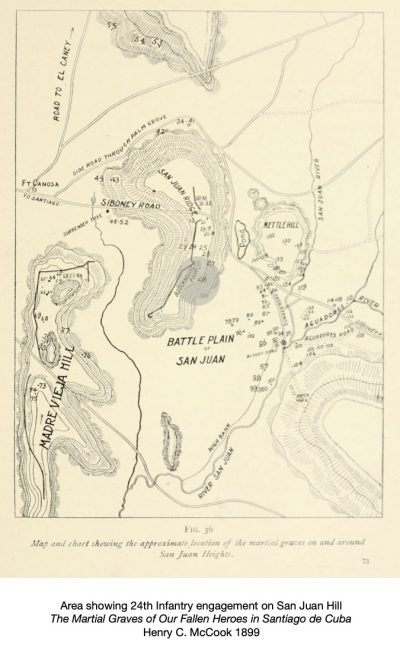 From Las Guasimas, the regiment plodding thru thick mud and mire which at times rose above their knees, forded streams, some with waist high water, and pushed thru thorny underbrush of cactus, mesquite, and undergrowth that cut into their uniforms. The single road traveled was so choked with moving troops the 24th advanced only four miles reaching a point at ten o’clock in the evening, and still a few miles from the front. With orders to lay down without pitching tents, the men tried to get as much sleep as possible as they lay on the damp ground. The only rations available were those retrieved by some of the unit’s soldiers who traveled back to Siboney carrying forward boxes of hard tack. [70]
From Las Guasimas, the regiment plodding thru thick mud and mire which at times rose above their knees, forded streams, some with waist high water, and pushed thru thorny underbrush of cactus, mesquite, and undergrowth that cut into their uniforms. The single road traveled was so choked with moving troops the 24th advanced only four miles reaching a point at ten o’clock in the evening, and still a few miles from the front. With orders to lay down without pitching tents, the men tried to get as much sleep as possible as they lay on the damp ground. The only rations available were those retrieved by some of the unit’s soldiers who traveled back to Siboney carrying forward boxes of hard tack. [70]
On July 1st, starting about 4:30 in the morning, thunder from the booming guns of the U.S. fleet in Santiago Bay signaled the start of battle. As the salvo of American batteries returned fire, the commander of the 24th, Emerson H. Liscum, ordered the regiment’s bugler to blow the general call. Following behind the Ninth and Thirteenth Infantries, they began their march. [71]
By eight o’clock, the men began their advance towards the front line marching down the Santiago Road. With each step forward, the sound of small arms fire became more distinct. After making headway about a mile distant, the road became nearly choked with wounded men and stragglers preventing the regiment from entering the battle zone. The morning was well advanced as it was already eleven thirty. [72]
Writing home to his sister after the battle, Corporal John R. Coon, of Company H., remembered the scene confronting his men that morning:
“It was terrible. There were wounded and dead men lying all along, beside and in the road, and the air seemed alive with bullets and shells of all descriptions and caliber. You could not tell from what direction they were coming; all that we could understand was we were needed further in front, and we could not shoot, for we could not see anything to shoot at.” [73]
Corporal Coon, recalling the encouraging words of Captain Allensworth back in Salt Lake City on the eve of departure still “ringing in our ears” to ‘Quit yourselves like men, and fight!’ felt the time had finally arrived for our “mettle to be tested.”
After the unit reached a place wide enough in the road to make a passing, Liscum, eager to join in the battle, asked permission for the 24th to pass the Ninth and Thirteenth Infantries. The 24th now took the lead. As they overtook the Thirteenth, cheers of “There go the fighters” and “There go the men that will make Spain tremble” greeted the troopers.
This was most likely where the Aguadores Road branched to the left of the Siboney Road and led towards the San Juan River and beyond to the heights where the Spanish defenders were located. [74]
Marching in double time, the regiment left the road at the fork where they found General Kent the commander of the 1st Division standing, “with tears running down his cheeks” pleading and admonishing the 71st New York Volunteers who had begun to retreat to stop and hold fast:
“…for the love of country, liberty, honor and dignity; in the name of freedom, in the name of God; for the sake of their dear mothers and fathers to stand up like men and fight, and go to the front.” [75]
The 71st had just been repulsed by heavy Spanish fire and panic stricken, were “recoiled in confusion.” All the attempts of “mandate, persuasion, and action” by General Kent and his staff officers could not induce the 71st to fight. The fork was a junction made where the Aguadores Road converged with another smaller road, called the Sunken Road. This road sank below the open plain that ran in front of the San Juan heights allowing a certain amount of protection from the Spanish volleys that came down from the heights. The protection allowed the various units to form battle lines. [75]
As the men of the 24th approached the scene of chaos, General Kent immediately recognized the men from his old command. He ran out, grasped the hand of Colonel Liscum and directed the officer to move the troopers to the left side of the road. Liscum smiled and assured the general, “My boys will not disgrace the flag.” [77]
The left hand route to San Juan hill was so congested by the first battalion of the 71st, as many of the men had “prostrated themselves in the path” the men of the 24th had to stumble and step over the members of the 71st who had been ordered to lay low amongst the thickets along the path. Despite the sights of the panicked men, dead, and wounded, the 24th moved ahead amongst a heavy storm of shot, shell, and bullets. The buffalo soldiers “never for a moment wavered.” This spot where the 24th met General Kent became known as “Bloody Angle” and “Bloody Bend” where a number of men were killed and wounded as they left the shelter of the rain forest into an open area ahead of the heights. [78]
Dropping excess equipment and holding onto only their canteens, rifles, and ammunition, the 24th “rushed like madmen” into the San Juan River confronting water up to their necks. Having crossed the river, the soldiers were afforded some safety along ground that had been eroded by the river and sunken into the ground creating a second bank in the river. Just past the river bank the soldiers had to cut thru a five strand barbed wire fence. [79]
Liscum then had the men advance two hundred yards thru an open field that ran about 500 to 600 meters from the Spanish line and take cover. The San Juan heights, projected above the plain, held the Spanish rifle pits that spread thunderous volleys of bullets towards those on the plain. Not much protection was afforded by the long grass and few trees found there. Being so exposed, the best chance for survival was to continue to move forward and face the Spanish line head on.
As the Spanish concentrated their fire on the prostrated men, general Kent stood up, waved his sword toward San Juan hill, and commanded his orderly to trumpet the order to charge. Shortly thereafter, Kent fell from a bullet hitting his left shoulder. [81]
A captain with the British Army, looking thru his spyglasses, watched as a blue line of soldiers moving against the Spanish trenches. With no artillery to support them, the men advanced up the hill, while “bullets, shrapnel, pieces of chain and flying railroad iron cut into [them] awfully.” [82]
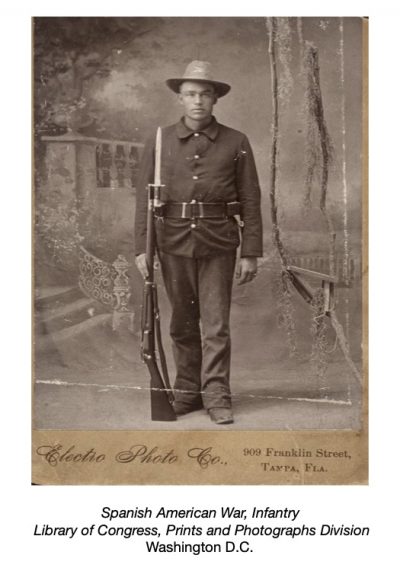
“Imagine a hill,” high and steep, rising at a thirty degree angle, “with rifle pits covering a large plateau at the base” with a “killing fire”raining down on men clambering upward. “Under one of the most murderous fires imaginable,” a charge had been called. The call was met by the 24th who led the charge up that treacherous hill. A witness to the battle of San Juan Hill on 1 July 1898 wrote home about the exploits of the 24th:
“There never were more heroic men than the blacks of the Twenty-fourth infantry. No one who saw their glorious charge will ever regret that we set them free.” Dr. Frank L. Winant
Upon encountering the Spanish fire, the Brigade’s commanding officer, Colonel Wikoff fell and died a few minutes later. Lieutenant-Colonel Worth of the 13th infantry took command but was soon severely wounded. Colonel J. C. Liscum, the commander of the 24th was then shot down. Lieutenant Colonel Ewers, leading officer of the 9th Infantry, took command leading the way to the ridge. In a short span of time the brigade lost four commanding officers. [84]
Reports of the battle indicated the 24th were the first to occupy the hill, “the brave blacks of the Twenty-fourth won on that day a standing in arms with the bravest of the brave.” During the heat of the battle, Colonel Harry Egbert, leading the Sixth Regiment, was seriously wounded and forced to disengage from his unit. He insisted giving a wounded soldier his litter. With the support of two “colored soldiers,” who placed Egbert’s arms on their soldiers, helped him back to the river. With his strength failing, Egbert staggered and fell into the water at the ford. The two soldiers dragged him out and sat him down on the bank to rest. Just then singing could be heard from above.
“Suddenly one of the negro soldiers clapped his hand to his side, and with joy beaming out of every lineament of his good-natured face said, or rather shouted, for he could not contain his satisfaction: ‘Don’t you hear ‘em, Colonel? Don’t you hear our boys singing ‘Hallelujah, Happy Land’ ? The colonel had other thoughts, and he answered wearily: ‘Hear what, my man?’ ‘Why, don’t you hear our boys singing on the hill? Colonel, you give ‘em the right steer, suah…They ain’t no regiment in the army that can sing like that but the old Twenty-fourth.’ …’ They’s up there Colonel suh. Fac’, I can almost see ‘em now. You gave them the right steer, suah, and they wouldn’t have gone up if you hadn’t told ‘em to.” [85]
Lamenting no notice had been appropriately given to the participation of the 24th in the battle, the Boston Herald wrote, no regiment had “distinguished itself more by gallantry” than the 24th. Further, noting three companies had lost every one of their officers, four captains had fell, and the unit’s lieutenant-colonel was severely wounded, this loss of leadership did not stop the regulars. Having “stood the fire with the steadiness of veterans,” their discipline remained “perfect under their severe exposure” from the fire landing all around them. [86]
“It seems now almost impossible that civilized men could so recklessly destroy each other as they did that day. All [sic] the crest of the hill, in their trenches and along the main road, there were piles of dead and wounded Spaniards. Colonel John R. Coon
The bravery of the regulars of the 24th becomes even more apparent in light of the circumstances they faced in Cuba. From the start, poor planning and inadequate logistical foresight became the cause of much suffering amongst the troops.
Undo Suffering
At the time of the San Juan fight, medical personnel faced nearly two thousand wounded soldiers without the availability of much needed medical supplies. Medicines and equipment lay in the transport ships out at sea or were left behind in Florida. Ambulances, baggage wagons, and needed medical supplies were in short supply during the most heated exchanges between July 1-3. An insufficient numbers of tents, cots, and bedding to support both the triage stations on the front lines and the main hospital forced many of the wounded to be left uncovered and exposed to intense heat and daily rain showers. Due to the lack of proper landing facilities, boats to transport supplies on shore, much of the needed supplies did not reach the troops until after the surrender of Santiago in the middle of July. [88]
Few litters were available to carry the wounded. This forced the soldiers to sacrifice their own protective canvas materials to be used as litters. Since baggage and ambulance wagons were left behind in Tampa, soldiers were loaded onto freight wagons. The road the wagons traveled consisted of no more than a rocky trail, made worse from torrential rains. Men were jostled about on the rough flooring and siding of the wagons. Many of the wounded were covered with splinters. The trip was agonizingly painful and added to the suffering. [89]
“There they lay, a squirming, writhing mass of naked, blood-stained , and bandaged limbs…You would have been moved to indignation had the bodies that were heaped together in this way been the bodies of the dead. But when you heard the low moans, the pitiful groans, and caught glimpses now and again of the pale, distracted faces, and the arms and hands stretched from out the writhing mass of men fruitlessly struggling to extricate themselves from their horrible position…” [90]
One army surgeon, who witnessed the “pitiless manner” of how the wounded and sick were packed onto wagons the “abominable condition of the roads, the unruly state of drivers and mules” the constant “jars and jolts” were excruciating and “cost the lives of not a few patients.” The wagons were springless and no straw or blankets were given as protection from the sun or rain. [91]
Even upon arrival to the hospital, many waited for days to receive medical attention. While waiting, many were exposed to the elements as proper shelter was in short supply even for the sick. Medical supplies were grossly inadequate due to the short supply most did not landing until after July 10th. The situation was grave, and more so with the outbreak of fever. [92]
Fever
The battle of Santiago ended on July 4th, but the Spanish did not officially surrender until the 16th. During that time American forces occupied the former Spanish trenches overlooking Santiago. Those not wounded were exposed to the relentless heat of the tropics, food shortages, and torrential rain which contributed to many of the soldiers becoming sick with fever.
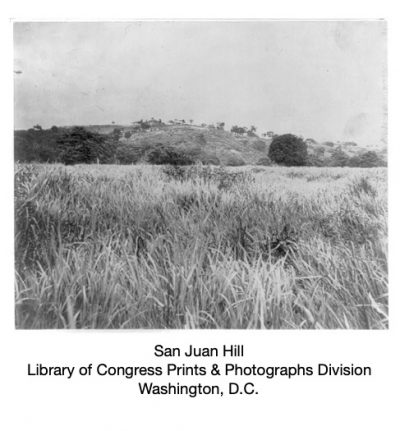
While awaiting the surrender of the Spanish forces, the 24th dug in. The men slept and ate in the defensive trenches they excavated. The men faced the blazing sun during the day, rain storms every afternoon, and the chill at night without shelter or ponchos as these were needed to “shroud the dead” or to make litters for the wounded and sick. Contributing to the misery of the conditions, the 24th, like most of the others troops, lacked food. [93]
What food the troops were given consisted mainly of canned bacon which they had subsisted on since the sea voyage to Cuba. By then, many could no longer stomach the fare. The canned meat was described as “soft, watery, insipid, agreeable to neither eye nor taste” appearing black and stringy, “a miserable apology for food in the hot climate, a slimy-looking mass of beef scraps” and “repulsive to the sight.” Besides the canned bacon, the only other nourishment came from hard tack, sugar, and coffee, and occasionally potatoes or onions. From the time the regiment landed in Cuba, on more that one day, rations were either short, or consisted only of bread and sugar. For example, on 14 July, the daily ration was reported to have consisted of two spoonfuls of roasted coffee, one and half pounds of sugar, fourteen ounces of hard bread, and one two pound can of tomatoes to be shared by seven men. The entire 24th regiment had no cooking utensils or camp kettles to boil water or cook food. Individual soldiers used tin cans to boil water in order to make coffee. [94]
On July 22nd, a report of the Inspector General described the men as filthy, with campaign hats worn out, the blue flannel shirts worn were rent, making “visible backs and shoulders.” Sleeves were tattered, and trousers “mud-bedaubed below the knee” and shined from the accumulation of “grease and dirt.” Due to the damp and humid climate, shoes became so tight from swelling feet and uncomfortable corns, the men had to cut or slit their shoes exposing their toes to the outside. [95]
The Inspector General’s report gave a vivid picture of the condition of the soldiers:
Their condition excites the deepest commiseration…their pallid faces were apathetic…their attitude was of extreme depression. Men reeled from weakness or staggered from vertigo.
Given these conditions, no wonder fever began to break out amongst the fighting men as their resistance wained and “diseases peculiar to hot climates” took their toll. Between July 5 and 20, the First Division had just over 800 men on the sick list. As more men became ill and an epidemic was feared, the 24th would face their greatest challenge; not from bullets but from yellow fever. [97]
Siboney & Yellow Fever
After spending two weeks in the Spanish trenches over looking Santiago de Cuba, the 24th received warm news they were to leave the hill and make camp. Nearly complete by four in the afternoon, a new order was received for the men to make an all out night march for Siboney. By six o’clock in the evening, the men were ready to march. In complete darkness, they plodded over mud soaked terrain. Frequently the men had to grasp one another’s hands to avoid getting lost in the “gloom or entangled in the briar and undergrowth.” Arriving at three in the morning and exhausted from making camp and a forced march, they lay on the ground to sleep. Ahead of the them could be seen the white tents that made up the Yellow Fever camp at Siboney. [98]
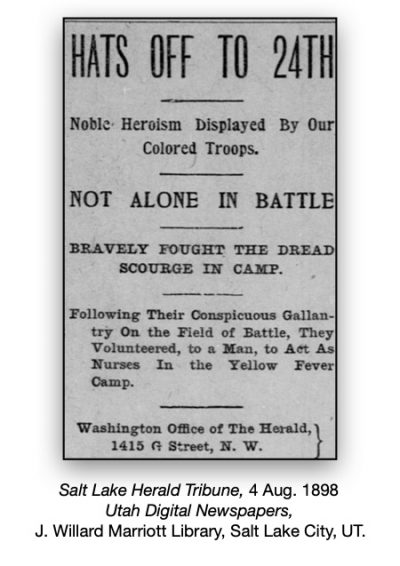
Not exactly sure what the regiment was called to do, Major Markley walked down the hill to inquire of the hospital staff. He was soon to discover his men were to be used as nurses and laborers at the yellow fever hospital. Seventy volunteers were called to attend to the yellow fever patients and to clean the the medical camp which was found in a considerable filthy condition. Rather than performing and military duties, the soldiers instead nursed the sick, policed the area, cooked food, unloaded supplies, burned refuse, destroyed infested buildings, and buried fellow soldiers. Many of those exposed to the virus became sick themselves and out of the more than four hundred men who arrived to help, only twenty-four failed to contract the disease. [99]
From 16 July to 26 August, the men of the regiment endured the depressing and heart breaking conditions surrounding them at the hospital camp in Siboney. Rarely complaining, they maintained their professionalism as soldiers, even working while sick. [100]
Chaplain Henry McCook, had been sent to Santiago as a member of the National Relief Commission of the Fifth Army Corps to establish a relief agency and report on the needs of the troops. McCook first hand knowledge of the conditions of the camp. He described Siboney as being synonymous with “all that is horrible in the annals of human suffering; a pest hole, a valley of death and the shadow thereof.” [101]
The Inspector General illustrated the conditions the men of the 24th encountered:
…we are confronted with a very grave state of affairs. It is a lamentable fact that there are hundreds of sick who are not receiving proper attention, care, or treatment. The sufferings and misery of this division can not be overstated. We hear their moans at night as they lay side by side…They have not change of clothing, no blankets, insufficient food. [102]
Col. Charles R. Greenleaf, Chief Surgeon of the Army in Cuba, in a report he filed in late August of 1898, was “embarrassed” due to the lack of nurses and guards available in Siboney. Due to the shortage of caretakers, Greenleaf asked for troops to perform nursing duties but was refused on two separate occasions by the commanding general of the Fifth Army Corps, General Shafter. He then appealed to General Miles, who then ordered the whole of the 24th Infantry to Siboney to perform the task. After making the night march, the troops arrived the next morning:
The necessity for aid was so urgent that I requested the commanding officer to call for volunteers from that regiment to serve in the yellow fever hospitals. This request brought forth a prompt response, more than twice the number of men required volunteering for this perilous duty. I desire to bring to the notice of the General Commanding the Army the conduct of these men. The cheerfulness with which they did their duty under the most adverse circumstances, and the promptness with which they volunteered for any service with the sick deserves, in my opinion, a special commendation. Col. Charles R. Greenleaf [103]
A news correspondent, Stephen Bonsal, provided a first hand account of the actions of the 24th while in Siboney. Bonsal was at army headquarters near the San Juan River, shortly before ten o’clock in the evening, when a column of troops could be heard singing as they marched in the mud. Their “deep, rich voices” rang out in the darkness and, as they marched past, the words of a hymn were recognized:
“When through the deep waters I call thee to go, The rivers of woe shall not thee overflow.”
Bonsal, remembered that night march vividly:
I only had an opportunity to press by the hand several of my friends in the gallant regiment, and to wish them God-speed as they marched on through the night; but for a long time after the column had disappeared, swallowed up in the darkness, I could hear the deep, manly voices of these brave men, who shirked no duty, whether upon the battlefield or in the noisome pesthouse, singing: “I’ll strengthen thee, help thee, and cause thee to stand, Upheld by my righteous omnipotent hand.” [104]
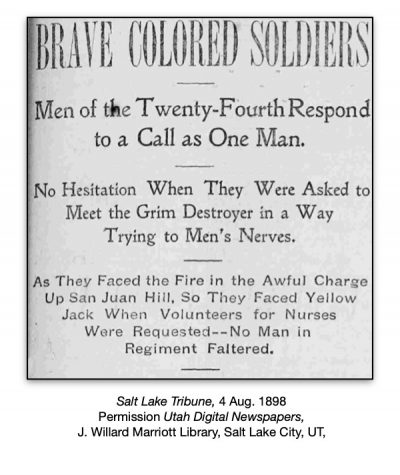
In Bonsal’s telling of the tale, the regiment was ordered to Siboney to only perform guard duty in order to prevent the contagion from breaking out any further. Upon arriving, Dr. Louis La Garde, the physician in charge made an appeal to Major Markley to allow some of his men to volunteer as nurses. Markley drew his men up in line whereupon the physician explained to those present the needs of the suffering while clearly explaining the danger involved in nursing the sick as well. Markley then asked for any man to step forward who wished to volunteer as nurses. After a moment, the entire regiment stepped forward. Sixty men were selected and within forty-eight hours, forty-two of these volunteers became seriously ill. Once again the regiment was called into formation, with the request of more nurses, the regiment stepped forward “to a man” once again. [105]
The “half sick” men of the 24th took to their work with “dogged resolution.” They dragged dead sand crabs from under cots, attended the sick and restrained “fever-crazed” patients. As roll call was made each day by Major Markley, a “tottering, worn out line of soldiers” responded with the call of their names. Markley would describe various details needed to be performed and would always announce, if any man were unable to perform any duty due to illness they should fall out. Not a man “would leave the line.” [106]
Each day tents had to be moved and rebuilt. This required digging trenches around the tents to prevent water from collecting and running through and under the cots where sick men lay. Such work was exhausting as the men where physically weak or themselves ill. [107]
In the Surgeon General’s report of 1898, it was noted African American troops were greatly affected by the yellow fever in Cuba having 232 cases and 36 deaths reported. These rates were higher than the cases attributed to white troops. The report clearly pointed to the “unusual prevalence of this disease among the colored troops was due to special influences affecting one regiment, the Twenty-fourth” who had exposed themselves while acting as nurses. Of the total number of yellow fever cases for African American troops in Cuba, 167 cases with 23 resulting in deaths were attributed to the 24th, or 74% & 64% respectively. [108]
If anything, the 24th broke the traditional view of the American military thought of the time; African American units, called “immunes” were less susceptible to malaria and yellow fever than white soldiers. In Cuba the admission rate of malarial fevers for African American units according to the Surgeon General, to be of “more frequent occurence [sic] but more dangerous among colored troops than whites.” When comparing admission rates of the two groups per one thousand, whites averaged 683 while African American regiments 834. Death rates for whites was calculated at 3.16 to 4.21 of African Americans. Again it was noted the higher incidence rates was most likely due to the 24th infantry performing guard and police duty at the hospital in Siboney, and “its members responded promptly to a call for volunteers to do duty in the yellow fever wards.” [109]
Further, the Surgeon General suggested while “every care was taken to protect the white regiments by removing them from the foci of infection, a colored regiment nobly volunteered for the dangerous duties of guard, police, and nursing in the yellow-fever hospitals of Siboney and Santiago. [110]
No wonder, Chaplain McCook would remark of the “heroic and humane action” of the 24th who had “deliberately walked into the jaws of the pestilence to serve their comrades and their fellow men.” [111]
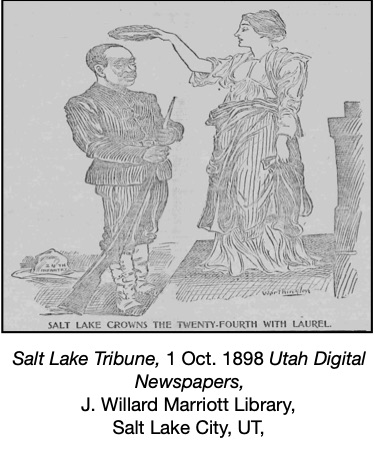
When news reached Salt Lake the service rendered by the 24th, the Salt Lake Herald Republican ran a front page article heralding the exploits of the 24th:
“…there is another phase of the valor of the colored soldiers, of which few have personal knowledge. The fever broke out at Siboney, and men were being carried up to the camp in the hills by the score, and it looked like the army was going to be swept away by the dread scourge. The supply of nurses was wholly inadequate to meet the demands of the situation. Men were fleeing for their lives from the disease, and the transports going north were crowded with terror-stricken men. But the Twenty-fourth infantry had been ordered from Siboney to the front to do police duty. There was a call for nurses. The officers of the Twenty-fourth called up their men and explained the situation, and asked for volunteers. This was not facing death on the battlefield, where valor would be recognized, but an invitation to meet the grim destroyer in that quiet way which is more trying to men’s nerves, but there was no hesitation on the part of the colored soldiers. As one man they stepped to the front to face this new and insidious danger, as they had faced death on the battlefield. It can be said again of him, that the colored soldier has fought nobly. No one in the ranks is entitled to more conspicuous honor than he.”
One might imagine the men of the 24th were inspired to endure the hazardous duty when asked by their officers, as each of the white captains of their units had fallen in battle, and so they felt it was their duty to perform as nurses. [113]
Many of the members of the 24th who died while performing their duties at Siboney were buried at the cemetery created near the General Hospital. Twenty soldiers lie along with Captain Charles Dodge in the hospital cemetery in Siboney, Cuba. A few others, whose graves have never been discovered, possibly lie in the cemetery in burials marked as “unknown.” [114]
Leaving Cuba
On 26 August 1898, when word arrived for the regiment to board onto the steamer Nueces for their homeward journey, of the 289 men who boarded only 198 were well enough to march onto the boat. [115]
The diary entry of Sergeant Major E. L. Baker of the Tenth Calvary recorded the decimated condition of the 24th upon arriving in Montauk, New York.
As these fever-worn veterans arrived at Montauk they presented a spectacle fitted to move strong men to tears. In solemn silence they marched from on board the transport Nueces…noiselessly they dragged their weary forms over the sandy roads and up the hill…in their soiled, worn and faded clothing, with arms uncleaned, emaciated, and with scarce strength enough to make the march before them, as they moved on that hot 2nd of September from the transport to the camp, they appeared more like a funeral procession than heroes returning from war…many a handkerchief were brought into view…to wipe away the tears that came from overflowing hearts. [116]
Back to Salt Lake City
When word arrived the 24th would soon be arriving back at Fort Douglas, the city began making preparations to honor the men. The troops arrived late on the evening of 30 September 1898 at the Oregon Short Line depot, and “reposed in the palatial sleeping cars” until the next morning. [117]
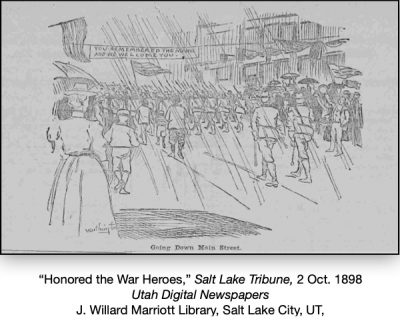
The “tears of heaven sanctified the glorious achievement of the marching heroes, and the dead and wounded soldiers” as a heavy downpour of rain, snow and sleet fell on the city the next day. Despite the inclement weather, twenty-thousand people participated in the welcome.
Awaiting the soldiers were cheering crowds at the depot who clamored to see the men as they began their march to the fort. “The cheers increased in violence and vigor” as the “throng swelled in numbers from every direction.” Salutes were fired, whistles blew from factories, and bells rang out, along with a chorus of “clangs” from “street car gongs” and tin horns accompanied by a “mass of humanity” who waved flags and kerchiefs of greeting. [118]
Escorted by a grand marshal and a platoon of police officers, the regimental band led the regiment forward with eight companies of infantrymen totaling four hundred and eighty men. The citizen parade followed with a public band, troops of the Grand Army of the Republic, the National Guard of Utah, the University club, and members of the local “colored” Masons. State officials, the mayor, and city council members came afterwards in carriages. All along the parade route, “cheers upon cheers” followed the men as they marched with hundreds along the curbs of the street offering greetings. Guns from the Veteran Artillery association fired salutes. [119]
Patriotic decorations in red, white, and blue were “veneered from cornice to pavement” on businesses along with a number of banners idolizing the exploits of the regiment:
A Hundred Thousand Welcomes to the Heroes of San Juan You Have Remembered the Maine Heroes Alike in Battle and Pestilence. You Are Most Welcome Out of the Cuban Jungles You Brought Immortal Fame You Have Quit Yourselves Like Men Welcome! You Have Fought a Good Fight You Exalted Your Race, Welcome! Now, Welcome! Welcome! Twenty-Fourth. Now Welcome to Thy Home! [120]
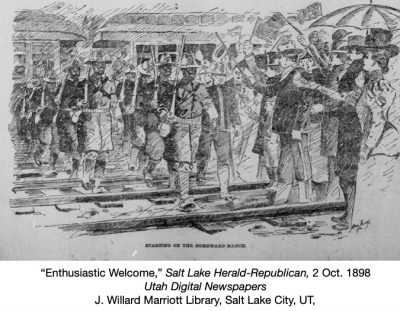
Finally, arriving at the fort, the soldiers were treated by the Red Cross ladies to a “substantial repast” of fried chicken, ham, baked sweet potatoes, hot rolls, pie, doughnuts, cheese, pickles, watermelon, peaches, and coffee. The ladies had decorated the “dingy old dinning rooms” with flowers, turning the halls into “bowers of beauty.” Bunting draped the room with autumn leaves strung overhead looking down at flower laden tables covered in white linen. The ladies labored hard to make the homecoming of the “heroes of San Juan” a “pleasant affair.” [121]
Of the number who had left for Cuba, thirty were killed or wounded with fifty dying from wounds or disease. Only part of the regiment returned to Fort Douglas. Only six companies returned as another four were located at Fort D. A. Russell in Wyoming. In a short time, the 24th would be called to serve in the Philippines. They were never to return to Fort Douglas. [122]
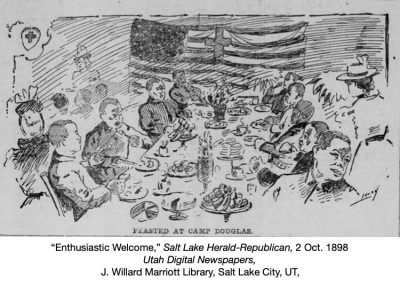
Kansas City & The New Bully Song
Back in April of 1898, as the 24th Regiment had a stop over and collected on the Union Depot platforms, a short performance by the regimental band was given as recorded in the newspaper. However, no mention was made in the article why these soldiers were on the cars of the Santa Fe railroad and leaving for Chickamauga from Kansas City late that evening. Only the colonel of the regiment was mentioned, J. Ford Kent. Rather, what was the most significant item concerning these soldiers as noted in the news paper article, was the performance of a ragtime tune by the regimental band. [123]
On that spring evening of 1898, the “joyous notes” from the regimental band “echoed among the train sheds.” The national anthem “America” was played with only a “scattering applause” given. Yet, when the band belted out a new tune, a “sudden shout” emanated from one end of the depot platform causing quite a stir. Men and women rushed about to “learn the cause” of all the commotion. “Cheers and yells and laughter” broke out as one of the most popular standards of the time was immediately recognized. “Played like only a negro band could play it,” the Kansas City Star reported, the notes floated above the noise of the trains. As the acclimations and hilarity of the moment grew louder, the song “was lost in the roar of human voices.” As the “negro band” played the newspaper recognized to the the tune, The New Bully Song The New Bully Song and noted the chorus line to the ditty, “When I Walk Dat Lebee Roun.”
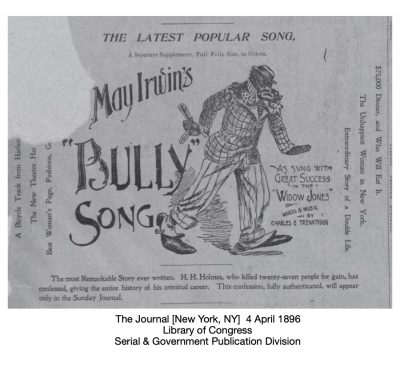
Sadly this composition was an example of a racists and offensive genre called “coon songs” which parodied African American’s speech, physical characteristics, and promoted demeaning stereotypes that had become popular in the 1890s. In 1906, the musical piece was described in the Washington Post as “the cleverest ‘coon’ song ever written.
This popular tune had been made famous by a vaudeville comedienne, Mary Irwin who performed the song in a three act farce comedy called The Widow Jones written by John J. McNally. Irwin had the leading role and sang most of the tunes in the play. The highlight of the production was her performance of The New Bully. [124]
The play was staged first in Brockton, Massachusetts on 19 Sept. 1895 where it made “a good impression.” After debuting at the Bijou Theatre on 16 Sept. 1895 in New York City, Irwin’s presentation of the New Bully, which included exaggerated pantomime and comedic gesturing on her part, was instrumental in making the song extremely popular while also making her a sensation. [125]
When the play was introduced in Boston, it was billed as having “negro melodies” sung by Irwin in “a fidelity to the African dialect and movement that made it very amusing.” A weekend performance in Boston on 16 Nov. 1895 illustrates how popular The New Bully song had become.
At the end of the last act of the play at the Harlem Opera House, the audience demanded Irwin to come back on stage . As she returned, the crowd cheered her “as no other actress has ever been cheered.” After thanking the crowd for the grand ovation, she replied “What more can I do?” In response, the crowd, in a “general shout,” demanded she sing The New Bully Song once again. After calling for her company to return to the stage, “the popular negro ditty was again sung amid great enthusiasm.” The New Bully “which many declare alone worth the price of a seat” as reported in the Boston Herald in December of 1895, would become very profitable for Irwin. [126- 127]
Kansas City theater patrons were well acquainted with May Irwin’s play where “it made an emphatic hit not soon to be forgotten” and headlined for a second tour in the city in 1896. [128]
The song was advertised in The Sunday Journal of New York, City on 10 April 1896 where it was peddled as “The Latest Popular Song – May Irwin’s Bully Song – As Sung With Great Success in the Widow Jones.” The art work of the advertisement depicted an African American male, dressed out in clown like clothing with a large bowtie, exaggerated lips, hairy and beast like hands, and carrying an open razor in his left hand. [129]
The very same illustration made up the front piece to the sheet music sold and published by the White-Smith Music Publishing Co. in 1896. The artwork featured a copyright notice given to W. R. Hearst of The Journal where it had first been introduced. A later edition of the music cover was published with a more refined and well dressed African American gentleman, wearing a top hat and holding a picture of Mary Irwin. The dapper figure peers behind the photo with a menacing scowl and open razor held in his left hand. [130]
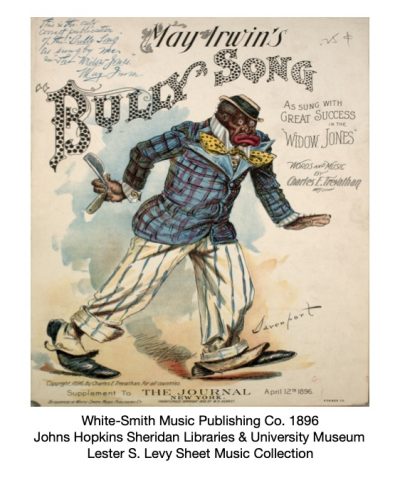
The 1890s brought about the proliferation of the “coon song” in many ragtime rhythms with both white and African American songwriters contributing to the genre. An early composition in 1896, was created by an African American, Ernest Hogan, called, All Coons Look Alike to Me, helped to explode the popularity of such songs. Many of these tunes were well received in minstrel shows that featured African American performers and audiences. Ironically, such compositions provided an opportunity for African American writers, musicians, and performers to move into the professional ranks and enjoy a certain amount of wealth. [131
As the decade progressed, the negative depiction of African Americans became increasingly racists and violent as illustrated in Irwin’s signature song. The New Bully lyrics introduced a new stereotype of African American males as jealous, razor toting criminals. The song highlighted a “colored gentleman” going down an alley armed with an axe and razor to kill his rival. [132]
The words “When I Walk Dat Lebee Roun,” were part of the chorus that was so well recognized by the crowds in Kansas City:
When I walk dat leve round, round, round, round, When I walk that levee round, round, round, round, When I walk that levee round, I’m a lookin’ for that bully an’ he must be found.
The lyrics of the ragtime tune are shocking from our modern day perspective:
Have yo’ heard about dat bully dat’s just come to town? He’s round among de niggers, a-layin’ their bodies down. I’m a-lookin’ for dat bully and he must be found. I’m a Tennessee nigger and I don’t allow No red-eyed river roustabout with me to make a row. I’m lookin’ for dat bully and I’ll make him bow. I went to a wingin’ down at Parson Jones’ Took along my trusty blade to carve dat nigger’s bones Just a lookin’ for dat bully, to hear his groans. I coonjined in the front door, the coons were prancing high For dat levee darkey I skinned my foxy eye. Just a lookin’ for dat bully but he wan’t nigh I asked Miss Pansy Blossom if she would wing a reel She says, “Law, Mr. Johnsing, how high you make me feel.” Then you ought to see me shake my sugar heel. I was sandin’ down the Mobile Buck just to cut a shine Some coon across my smeller swiped a watermelon rin I drawed my steel dat gemmen for to fin’ I riz up like a black cloud and took a look aroun’ There was dat new bully standin’ on the ground. I’ve been lookin’ for you nigger and Ive’ got you found. Razors ‘gun a flyin, niggers ‘gun to squwk, I lit upon that bully just like a sparrow hawk, And dat nigger was jus a dyin’ to take a walk. When I got through with bully, a doctor and a nurse Wa’nt no good to dat nigger, so they put him in a hearse, A cyclone couldn’t have tore him up much worse. You dont hear ‘bout dat nigger dat treated folks so free Go down upon the levee, and his face you’ll never see. Dere’s only on boss bully, and dat one is me.
ENCORE
When you see me comin ‘hist your windows high; When you see me goin’hang your heads and cry; Im lookin’ for dat bully and he must die. My madness keeps a risin’ and I’se not gwine to get left, I’, gettin’ so bad dat Im askeerd of myself. [133]
The song remained popular a number of years, with Irwin even recording it in 1907. [134]
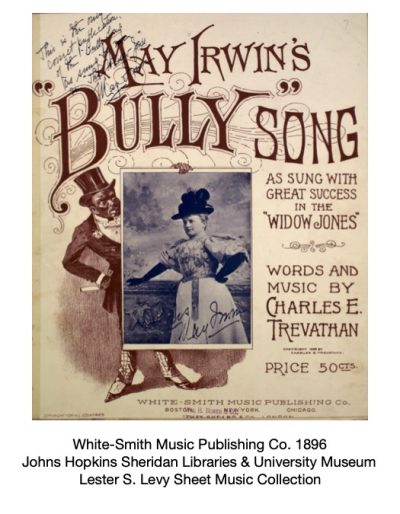 The explosion of such racists and demeaning songs in this period corresponds with an era that brought about an increasing number of civil rights setbacks for African Americans. Jim Crow laws, reversals in voting rights, enforced segregation, and an increase in lynchings marked the decade. Additionally, a free wheeling proliferation of demeaning characterizations of African Americans flooded mainstream popular culture, art, and print. Much of the music and stage performances reflected an increasing cultural antagonism and negative perceptions of African Americans in general. [135]
The explosion of such racists and demeaning songs in this period corresponds with an era that brought about an increasing number of civil rights setbacks for African Americans. Jim Crow laws, reversals in voting rights, enforced segregation, and an increase in lynchings marked the decade. Additionally, a free wheeling proliferation of demeaning characterizations of African Americans flooded mainstream popular culture, art, and print. Much of the music and stage performances reflected an increasing cultural antagonism and negative perceptions of African Americans in general. [135]
Certainly the song did not represent the true character of these proud African Americans who would fight and serve with such distinction. Yet, one might ask, why did these proud soldiers play such a demeaning tune as the New Bully?
Many academic researchers have postulated why African Americans participated in these forms of degrading entertainment, but in the case of the 24th a rather straightforward explanation can be entertained. [136]
Playing of the New Bully may simply have been an example of intelligent self survival. As the troopers waited along the depot platforms that spring evening, did they sense a certain amount of trepidation or possible confrontation as the crowds gawked at them? Then, to quell any possible growing antagonism, did the band respond by playing the offensive piece to appease the crowd and make the soldiers presence less threatening?
Another incident along the Union Depot in Kansas City may offer support for such a hypothesis.
In late September of 1898, the 1st Calvary and Ninth Infantry, two African American units which served in the Spanish American War, stopped in Kansas City before departing to points west. The chaplain of the Ninth, Charles W. Prioleau, was so incensed by the reception given to them, he wrote a biting letter of complaint to the Cleveland Gazette.
Describing Kansas City as the “gateway to America’s hell,” Prioleau, recalled how upon arriving the men were treated “unkindly and sneeringly received.” Additionally, the troopers were not allowed to stand at the counters of restaurants or even “eat a sandwich or drink a cup of coffee.” All the while, white soldiers, according to Prioleau, were well received and “invited to sit down at the tables and eat free of cost.” In his letter he clarified an underlying truth. He explained; “You call this treatment American ‘prejudice,’ I call it American ‘hatred’ conceived only in hellish minds.” He argued, there were few places in the country “where this hatred of the Negro is not” rather, you could find it, “in every department and walk of our country.”
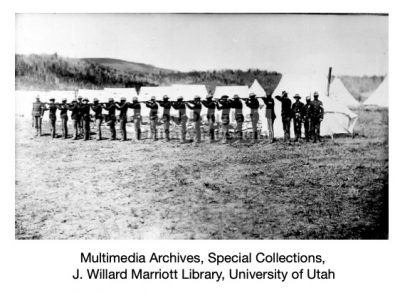
Captain Allensworth of the 24th Regiment had a similar greeting in Kansas City back in 1886 while making his way to his post of duty out west. Wearing his newly made officer’s uniform and carrying his orders signed by the Adjutant General of the Army, he arrived in Kansas City at Union Depot. His train reached the depot late causing Allensworth to miss his connection requiring him to find overnight lodgings. After being directed to the Blossom House, a well known hotel in the West Bottoms directly across the street from the depot, Allensworth obtained a room paying for a single night. Escorted by a bell boy, upon reaching the elevator, the clerk of the hotel confronted Allensworth. After the clerk asked the captain if he was a “colored man,” Allensworth responded, “this was not a very nice question to ask an officer of the United States Army.” In response, the clerk stated, “I can’t help what you are. If you are a colored man you can’t stay in this house.” Already, one o’clock in the morning, the captain requested his money returned and made his way back out into the street. [137]
The reception the 24th Infantry received in Kansas City in 1898 was in direct contrast to the experiences they had known in Salt Lake and the white officers who knew them as men. The crowds in Kansas City gave no thought to what these soldiers represented or any consideration to the commitment they were to soon fulfill for their country.
Lessons
The men of the 24th were able to transcend the evils of hatred and bigotry with dignity and honor, serving their country and humanity as well. They “quit themselves as men and fought” such indignities. In more ways than one, these soldiers were a truer image of the ideals of patriotism and unfailing service to human kind. They serve as examples of the higher parts of us and our potential as human beings. They ought to be remembered and their story told.
In 1902 the Governor of Utah, Heber W. Wells, pinned a personal letter to Chaplain Allensworth reflecting warm sentiments of the regiment who had “won our hearts in the beautiful little garrison above our city” and desired to see the regiment return to Fort Douglas. [138]
In some ways the 24th never left for their spirits still linger. I am confident, if we listen closely, we might hear the regimental band playing. The cheers and shouts from the baseball diamond where the Browns battled shift in the air. The clamor of the crowds still ring out when the troops marched thru the streets of Salt Lake. Talk of their heroics of service to fellow soldiers at the fever camp in Cuba and the tales of the regiment’s infamous fight up San Juan Hill are still spoken of by the ancients.
ENDNOTES
JWML : J. Willard Marriott Digital Library, University of Utah, Salt Lake, City, digital images, newspapers.lib.utah.edu.
RSG (1898): Report of the Surgeon-General of the Army to the Secretary of War for the Fiscal Year Ended June 30, 1898 (Government Printing Office: 1898).
Commission Report: Report of the Commission Appointed by the President to Investigate the Conduct of the War Dept. in the War with Spain, United States. Congress 1899-1900). Senate. (1900), Vol 1, (Gov. Printing Office, Washington : 1900); digital images, Hathitrust, (https://babel.hathitrust.org : accessed on 6 Sept. 2019).
SLT: Salt Lake Tribune.
DEN: Deseret Evening News
SLH: The Salt Lake Herald
[1] “The New Bully” for Them, Kansas City Star, 23 April 1898, pg. 2, col. 5.
[2] “Buffalo Soldiers and the Spanish-American War,” 28 Feb. 2015, National Park Service ( https://www.nps.gov/prsf/learn/historyculture/buffalo-soldiers-and-the-spanish-american-war.htm : accessed on 20 July 2019).
[3] “24th Infantry Regiment (1866-1951),” BlackPast ( https://www.blackpast.org/aaw/vignette_aahw/24th-infantry-regiment-1866-1951/ : accessed on 27 June 2019. “The Fort Douglas Browns – History of the Men of the 24th Infantry Regiment,” Part 1, Ronald Auther, 2019, digital article ( shadowballexpress.com : accessed on 22 July 2019).
[4] [5] Kenneth Jones, Jr., The Last Black Regulars, USAWC Strategy Research Report, ( U.S. Army War College, Carlisle Barracks, PA., : 2000) 18-19, digital images ( http://citeseerx.ist.psu.edu : accessed on 11 Nov. 2019).
[6] “An Unfortunate Change,” SLT, 20 Sept. 1986, pg. 12, JWML.
[7] “Utah’s Colored Troops,” DEN, 8 Oct. 1896, pg. 8, JWML.
[8] “Capt. Hoffman’s View,” SLT, 23 Sept. 1896, pg. 7, JWML.
[9] “The Race Question,” SLH, 20 Oct. 1896, pg. 6, JWML.
[10] “The Colored Troops,” SLH, 28 Nov. 1896, pg. 5, JWML.
[11] “The Twenty-Fourth Infantry,” SLT, 24 Oct. 1897, pg. 12, JWML.
[12] “Fort Douglas, Utah,” Army and Navy Journal, 7 Nov. 1896 pg. 157.
[13] “New Troops Arrive,” SLT, 16 Oct. 1896, pg. 8. JWML.
[14] “The Twenty-Fourth Regiment,” Broad Axe, 24 Oct. 1896, pg. 4. col. 1, JWML.
[15] “The Soldier Fracases,” SLT, 17 Dec. 1897, pg. 5, JWML.
[16] “Fort Douglas Notes,” SLT, 16 May 1897, pg. 4, “At the Military City,” 12 Aug. 1897, pg. 2, JWML.
[17] “Fort Douglas Notes,” SLT, 11 Apr. 1897, pg. 5., 28 April 1897, pg. 2, JWML. See Auther, Ronald, The Fort Douglas Browns.
[18 – 19] “The Colored Boys Win,” SLH, 10 May 1897, pg.2, JWML.
[20] “Park Boys Defeated,” & “Started With High Hopes,” SLT, 17 May 1897, pg. 5, JWML.
[21] “Park Boys Defeated.” 17 May 1897.
[22] “Browns Victorious,” SLH, 18 May 1897, pg. 6, JWML
[23] “Soldiers Got One,” SLT, 28 June 1897, pg. 5, JWML.
[24] “Was a Great Contest,” SLH, 19 July 1897, pg. 8, JWML.
[25] Ibid, & “Best of the Season,” SLT, 19 June 1897, pg.8, JWML.
[26] “Was a Great Contest.”
[27] “Best of the Season.”
[28] “Won By The Browns,” SLT, 9 Sept. 1897, pg. 8, & “The Grocers Defeated,” SLH, 9 Aug. 1897, pg. 8, JWML.
[29] “Fort Douglas Notes,” SLT, 16 May 1897, pg. 4, 28 Nov. 1897, pg. 5, JWML.
[30] “Will Not Leave Today,” SLT, 4 Apr. 1898, pg. 8, & “Brown’s Last Ball Game,” 18
Apr. 1898, pg. 8, JWML. Note: After the war, many men of the 24th regiment were discharged, companies relocated, and otherS sent to the Philippines preventing the creation of a baseball team. Additionally, in 1899, the Salt Lake City council reactivated an 1881 blue law preventing any baseball games to be played within city limits. Finally, thru the efforts of a private citizen, the military agreed to disallow any civilian games at the fort and a deal was made to purchase the grand stand and fencing which permanently removed baseball from the fort; Ronald, Auther, Men of the 24th Infantry Regiment, Part IV.
[31] “Athletics at the Fort,” SLH, 18 May 1897, pg.2, JWML.
[32] “New Troops Arrive,” SLT, 16 Oct. 1896, pg. 8, JWML
[33] “Fort Douglas Notes,” SLT, 16 May 1897, pg. 4, 18 July 1897, pg. 7,JWML.
[34-35] “At the Military City,” SLT, 16 May 1897, pg. 4, 12 August 1897, pg. 2, JWML.
[36] Roger D. Cunningham, “The Loving Touch”, The Professional Bulletin of Army History, (Summer 2007), e-journal (https://history.army.mil/armyhistory : accessed on 31 Oct. 2019.); “Fort Douglas Notes,” SLT, 23 Jan. 1899, pg. 14, JWML.
[37] “Emancipation Day,” SLH, 22 Sept. 1897, pg. 5, JWML.
[38 – 39] Alexander, Charles, Battles and Victories of Allen Allensworth, (Sherman, French & Company, Boston: 1914) 253 & 290.
[40] “The Twenty-Fourth Regiment,” Broad Ax, 24 Oct. 1896, pg. 4, JWML.
[41- 42] Alexander, 298.
[43] “School for Fort Douglas,” SLT, 31 Oct. 1897, pg. 9; “Fort Douglas Notes,” SLH, 24 Jan. 1897, pg. 7, JWML.
[44] “Emancipation Day,” SLH 22 Sept. 1897, 5, JWML.
[45] “Fort Douglas Notes,” SLH, 1 Mar. 1897, pg. 8.; “At the Military City,” SLH, 20 Apr. 1899. pg. 3, JWML.
[46] Alexander, pg. 298, 305; “Church Appointments,” SLT, 29 Aug. 1897, pg. 4, JWML.
[47] “Tears and Love for the Blue,” SLR, 1 June 1897, pg. 6, JWML.
[48] “Troops Did Not Leave,” SLT, 20 April 1898, pg. 5, JWML.
[49] “Will Not Leave Today,” SLT, 18 Apr. 1898, pg. 8, 28 Nov. 1897, pg. 5, JWML.
[50] Alexander, 349.
[51-52] “They Have Gone to the Front,” SLH, 21 Apr. 1898, pg. 8. JWML.
[53] Hill, Stephen H., “Allen Allensworth (1842-1914),” BlackPast ( https://www.blackpast.org/african-american-history/allensworth-allen-1842-1914/ : accessed on 27 June 2019.).
[54] “Fort Douglas Notes,” SLT, 10 April 1897, pg.15, JWML.
[55] “Troops Did Not Leave,” SLT, 20 April 1898, pg. 5, JWML.
[56] Ibid, “Was a Day of Disappointment,” SLH, 20 Apr. 1898, pg. 8, JWML.
[57-58] “They Leave for Cuba,” SLT, 21 Apr. 1898, pg. 5, JWML.
[59] “They Have Gone to the Front,” SLH, 21 Apr. 1898, pg. 8, JWML.
[60] “They Leave for Cuba,” SLT, 21 Apr. 1898, pg. 5, JWML.
[61] “They Have Gone to the Front,” SLH, 21 Apr. 1898, pg. 8, JWML.
[62-63] “They Leave for Cuba”
[64] “They Have Gone to the Front”
[65] Bonsal, Stephen, The Fight for Santiago, ( Doubleday & McClure Co., New York : 1899), 433-34; McSherry, Patrick, The Transport Service, on-line article, The Spanish American War Centennial Website, 2012 ( http://www.spanamwar.com/transports.htm : accessed on 29 Aug. 2019). Willard S. Squire III, The 24th Infantry Regiment and the Racial Debate in the U.S. Army, dissertation ( Fort Leavenworth, Kansas: 1997) digital images (https://apps.dtic.mil/dtic/tr/fulltext/u2/a331757.pdf : accessed on 11 Nov. 2019), 62; Herschel V. Cashin, et al., Under Fire With the Tenth U.S. Calvary, (Chicago: American Publishing House, 1902), 123.
[66] RSG (1898), Lieut. Col. B.F. Pope, Chief Surgeon, U.S. Volunteers, “Report of the Chief Surgeon of the Fifth Army Corps. Giving a Brief Account of the Operations of the Medical Department from April 23, 1889, to July 23, 1898.” pg. 184. Commission Report: Testimony of Capt. Frederick E. Ebstein, Burlington, VT., 8 Nov. 1898, pg. 1490.
[67] Commission Report: Testimony of Capt. Frederick E. Ebstein, pg. 1490.
[68] Commission Report: Testimony of Capt. Frederick E. Ebstein, pg. 1490; Corporal John R. Conn, Company H, 24th Regiment, digital image, Chronicling America, “Brave U.S. Troops,” The Evening Star, Washington, D.C., 17 Sept. 1898, pg. 11.
[69] Giessel Jess & McSherry, Patrick, “US Order of Battle, 1898,” The Spanish American War Centennial Website (http://www.spanamwar.com > Unit Profiles, Roster & Photos > Orders of Battle > US Order of Battle : accessed on 5 Jan 2020); Willard S. Squire, III, pg. 64.
[70] Cashin, 124-25. John R. Coon, “Brave U.S. Troops,” The Evening Star (Washington, D.C.), 17 Sept. 1898, pg. 12. Note: According to Herschel Cashin the regiment did not arrive until midnight.
[71] Cashin, 128.
[72-73] Coon; Cashin, 126.
[74] Cashin, 126, See illustration “Battle Plain of San Juan Hill.
[75] Cashin, 128.
[76 -77] McCook, Henry C., The Martial Graves of Our Fallen Heroes in Santiago de Cuba, (George W. Jacobs & Co, Philadelphia: 1899) 102; Commission Report, “The Assault Upon and Capture of Fort San Juan,” Inspector General Report, 1 July 1898, pg. 354.
[78] Sargent, Herbert H., The Campaign of Santiago De Cuba, Vol. II. (A.C. McClure & Co., Chicago: 1907) 115. Commission Report: Hammock of the inspector-general of Brigadier General Kent’s division, Friday, July 1, 1898. Assault Upon and Capture of Fort San Juan, pg. 354; Willard S. Squire, III, 64; Quote of Kent: John R. Coon, 17 Sept. 1898; McCook, The Martial Graves, 102.
[79] Commission Report: Ibid, pg. 357; Squire, 65; Cashin, 130; McCook, 101.
[80] McCook, 106.
[81] Cashin, 130.
[82] “The Battle of San Juan,” SLT, 5 Aug. 1898, pg. 4, JWML.
[83] “Charge Led by 24th,” SLT, 14 Aug. 1898, pg. 5, JWML.
[84] McCook, 120.
[85] Bonsal, 170.
[86] “The Colored Troops,” Boston Herald, 9 Jul. 1898, pg. 4.
[87] Coon, 17 Sept. 1898.
[88] Commission Report: Subsistence Department Brig. Gen. Charles P. Eagon, Commisary-General, U.S.A., In Charge, pg. 174.
[89] Gillett, Mary C., The Army Medical Department 1865-1917, Army Historical Series, (Center of Military History United States Army, Washington, D.C: 1995), 142-45, digital image, U.S. Army Medical Dept., Office of Medical History, (https://history.amedd.army.mil/booksdocs/spanam/gillet3/default.html : accessed on 27 Aug. 2019).
[90] Bonsal, 209.
[91] Ibid.; Commission Report: Testimony of Private J.B. Houston. Boston, MA, 29 Nov. 1898, pg. 2537.
[92] Commission Report: Testimony of Capt. Edward L. Munson, Washington, D.C., 16 Nov. 1898, pg. 1877.
[93] Commission Report: Hammock of the inspector-general of Brigadier General Kent’s division, pg. 368
[94] Commission Report: Philip Reade, Major, Inspector-General, First Division, Fifth Army Corp., undated, pg. 375. Testimony of Capt. Frederick E. Ebstein, Burlington, VT., 8 Nov. 1898, pg. 1491 & Brief of Reports Submitted to Regimental Commanders (chart), “Twenty-fourth Infantry, Major Thompson’, pg. 357, “The Assault Upon and Capture of Fort San Juan,” Inspector General Report, 1 July 1898, pg. 365.
[95 – 96] Commission Report: Philip Reade, pg. 377 -378 [97] Commission Report: Philip Reade, pg. 370 & 380.
[98] “Heroes at Siboney, Too,” SLT, 19 Sept. 1898, pg. 3, JWML.
[99] Squire, 65-66; Gould, pg. 224.
[100] Ibid, Squire.
[101] McCook, 284.
[102] Commission Report: Philip Reade, Major, Inspector-General, First Division, Fifth Army Corp., undated, pg. 380-81.
[103] RSG (1898), Col. Charles R. Greenleaf, Chief Surgeon Army in the Field, “Report of Operations of the Medical Dept. at Santiago, Cuba….” 24 Aug. 1898, pg. 145.
[104-105] Bonsal, 433-34.
[106-107] “Heroes at Siboney, Too,” SLT, 19 Sept. 1898, pg. 3, JWML.
[108 – 110] RSG, 81, 288, 238.
[111] McCook, 284.
[112] “Hats off to the 24th,” SLH, 4 Aug. 1898, pg. 1, JWML.
[113] Gould, 224.
[114] McCook, 284.
[115] Gould, 225.
[116] Gould, 247- 48.
[117] “Enthusiastic Welcome to Victorious Soldiers,” SLH, 2 Oct. 1898, pg. 1& 3, JWML.
[118] Ibid; “Honored The War Heroes,” SLT, 2 Oct. 1898, pg. 1, JWML.
[119 – 120] “Honored The War Heroes.”
[121] Ibid; “Return of the Twenty-Fourth,” Deseret Weekly, 8 Oct. 1898, pg. 27, JWML.
[122] Ibid; Squire, 66.
[123] “The New Bully for Them,” Kansas City Star, 23 April 1898, pg. 2, col. 5.
[124] “Story of ‘The New Bully.’ Washington Post, 11 Feb. 1906, pg. 69.
[125] “The Widow Jones,” Boston Herald, 25 Aug. 1895, pg. 18, col.5., “Boston’s New Productions,” The New York Times, 3 Sept. 1895, pg. 3, col. 4-5, “The Widow Jones,” The Evening World (New York, N.Y.), 17 Sept. 1895, pg. 4.;
[126] “A Great Compliment,” Boston Herald, 19 Nov. 1895, pg. 7, col.6.
[127] “Widow Jones in Town,” Boston Herald, 1 Dec. 1895, pg. 28.
[128] Untitled article, The Kansas City Journal, 6 Dec. 1896, pg. 12, col. 2.
[129] The Journal (New York, N.Y), 10 April 1896, pg. 6, digital image, Library of Congress, newspaper collection, (https://www.loc.gov : accessed on 13 Jan. 2020).
[130] May Irwin’s Bully Song, Charles E. Trevathan: composer, (White-Smith Music Publishing Co, New York: 1896), digital image, Johns Hopkins Sheridan Libraries & University Museums, The Lester Sheet Music Collection, “May Irwin’s ‘Bully’ Song, box 142, item 046 (http://levysheetmusic.mse.jhu.edu/collection/142/046 : accessed on 12 Jan. 2020).
[131] “Ragtime and the Coon Song,” History of Minstrelsy From ‘Jump Jim Crow’ to ‘The Jazz Singer,’ University of South Florida Libraries, (https://lib.usf.edu > USF Libraries > Collections > Special Collections > Exhibitions: accessed on 12 Jan. 2020).
[132] In Search of Coon Songs, Racial Stereotypes in American Popular Song, on-line article, Parlorsongs.com > site map > Parlor Songs Academy, Quick Find Index: Special Articles – “Coon” Songs, April 2000 (http://parlorsongs.com/insearch/coonsongs/coonsongs.php : accessed on 11 Nov. 2018); John Adcock, Mary Irwin, Queen of Ragtime, Yesterday’s Papers, 14 June 2012, john-adcock.blogspot.com (http://john-adcock.blogspot.com/2012/06/may-irwin-queen-of-ragtime.html : accessed on 11 Nov. 2019).
[133] Sheet music, May Irwin’s Bully Song, Charles E. Trevathan, (White-Smith Music Publishing Co, New York: 1896), digital image, Johns Hopkins Sheridan Libraries & University Museums, The Lester Sheet Music Collection, “May Irwin’s ‘Bully’ Song, box 142, item 046 (http://levysheetmusic.mse.jhu.edu/collection/142/046 : accessed on 12 Jan. 2020).
[134] Charles E. Trevathan: Composer, Soprano Vocal May Irwin: Vocalist, and Charles E. Trevathan: Lyricist. The Bully. 1907, audio recording, The Library of Congress (https://www.loc.gov/item/jukebox-124996/ : accessed on 13 Jan. 2020.
[135] Knowlton, Steven A., Show Me the Race of the Nation Without a Flag, and I Will Show You a Race of People Without Any Pride…, Raven A ., Journal of Vexillology, Vol. 24, 2017, pg. 30.
[136] Schroeder, Patricia, Passing for Black: Coon Songs and the Performance of Race,” Paper presented at the annual meeting of the American Studies Association Annual Meeting, Renaissance Hotel, Washington D.C., Nov 05, 2009, 2014-11-28 <http://citation.allacademic.com/meta/p314836_index.html>; Lemons, J. Stanley, Black Stereotypes as Reflected in Popular Culture, 1880-1920, American Quarterly, Vol. 29, No.1, (Spring 1977), pgs. 102-116.
[137] Allensworth, 257.
[138] Alexander, 389.
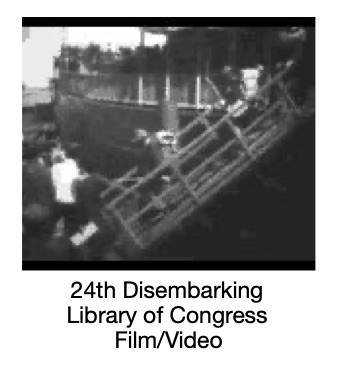
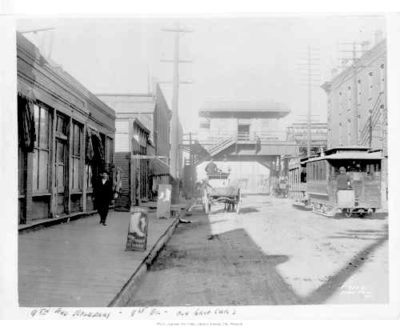

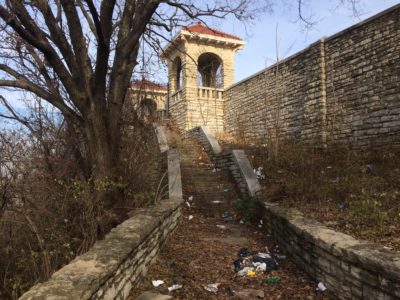 Secondly, all the efforts the city put in beautifying the unsightly area and transforming it into an appealing panorama sadly has deteriorated back to an eyesore.
Secondly, all the efforts the city put in beautifying the unsightly area and transforming it into an appealing panorama sadly has deteriorated back to an eyesore.
